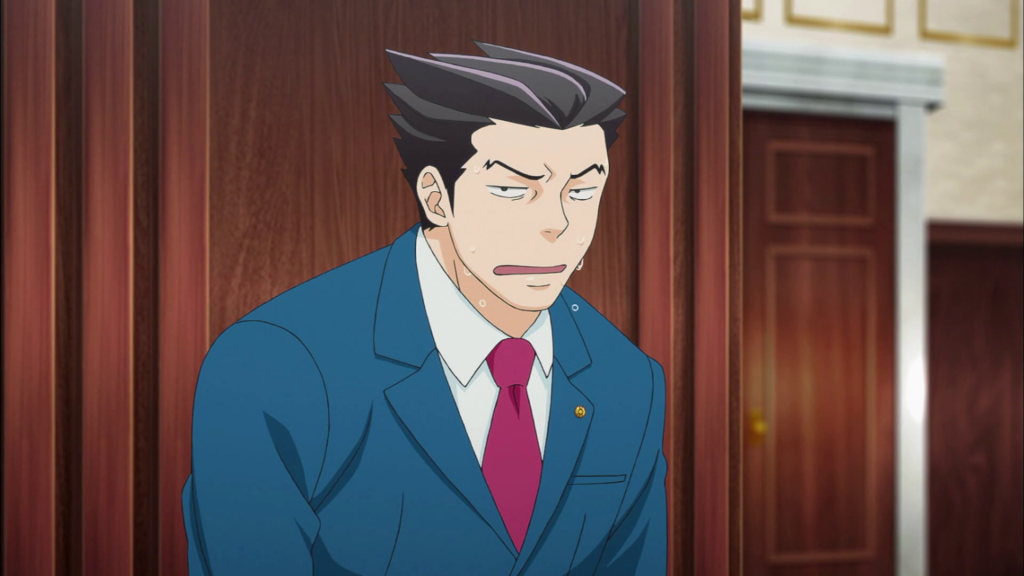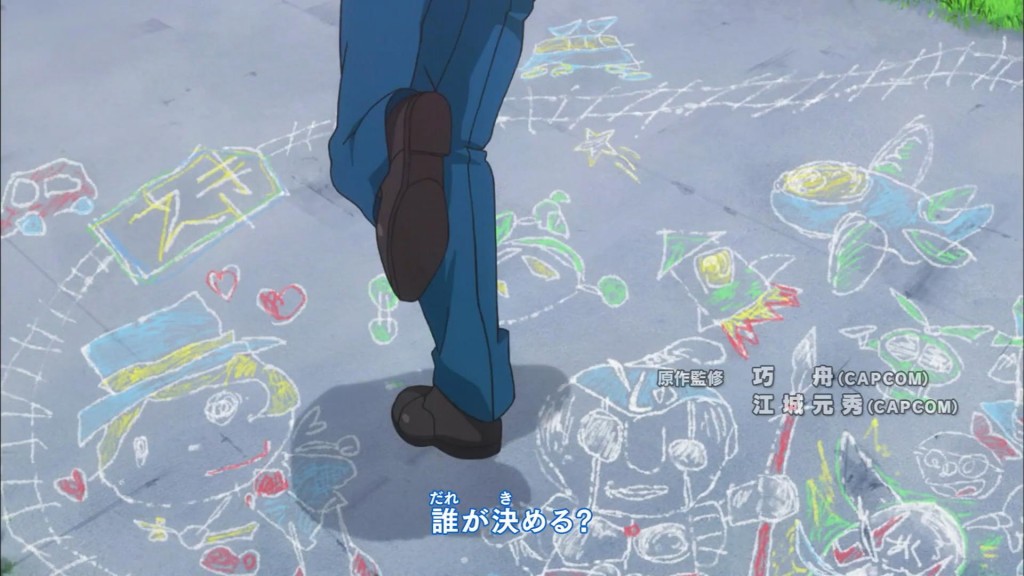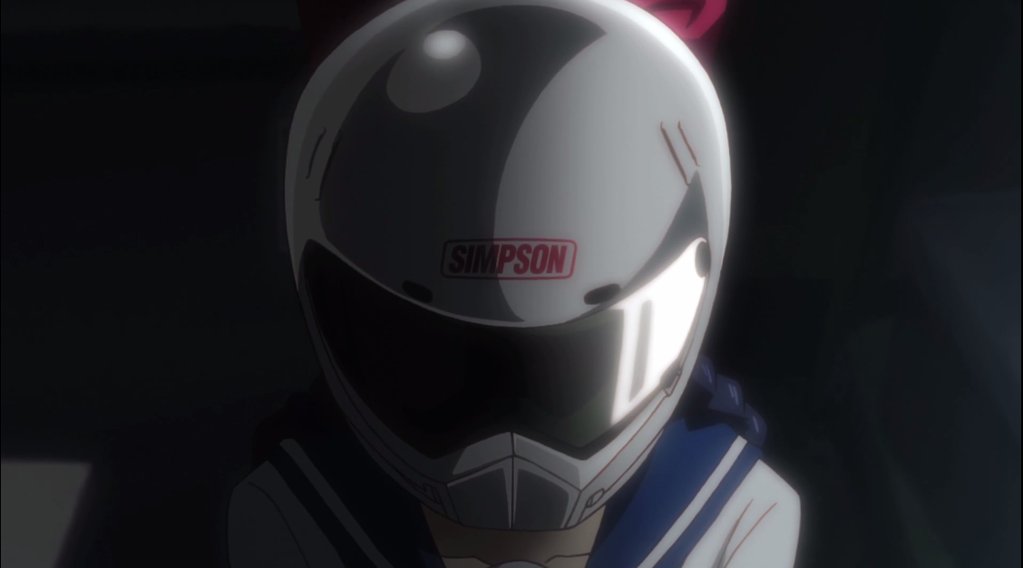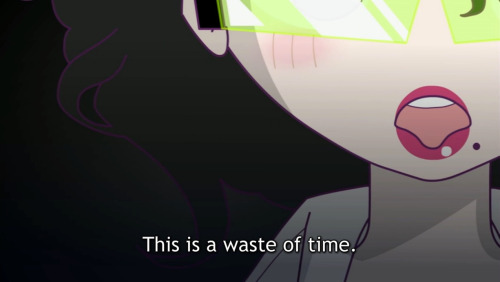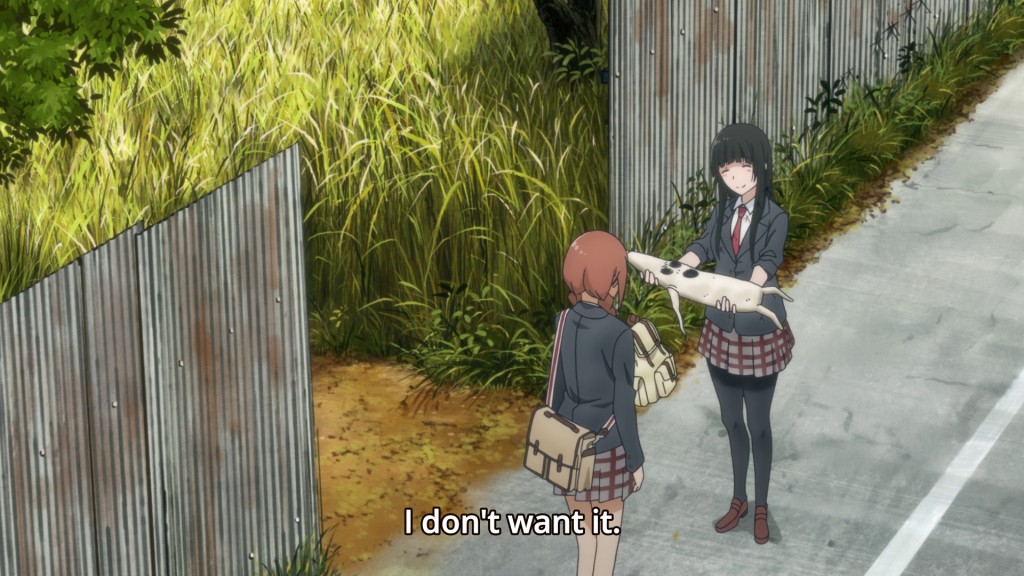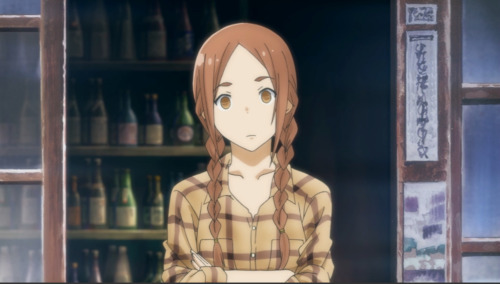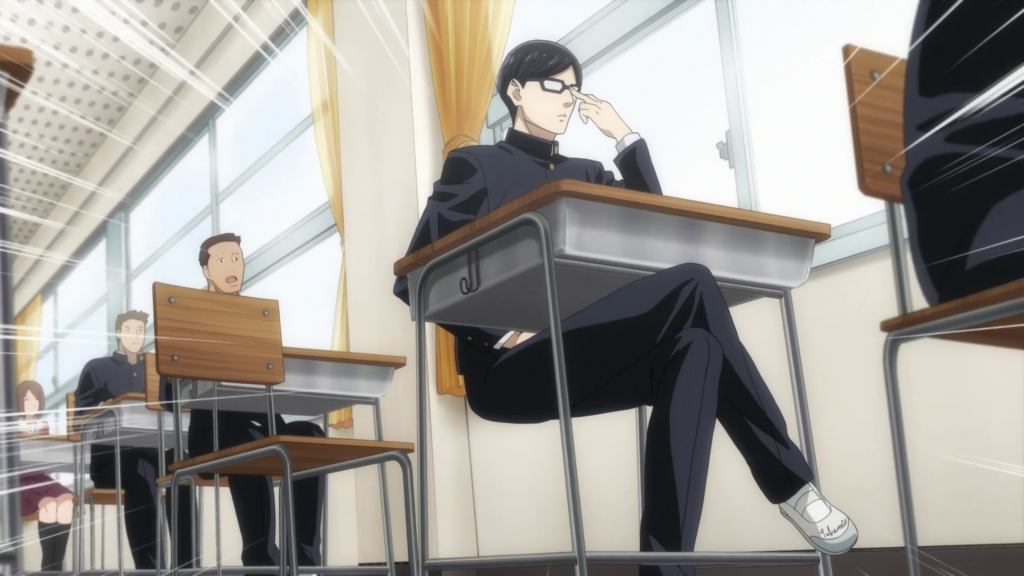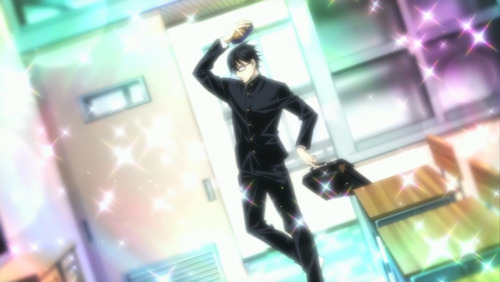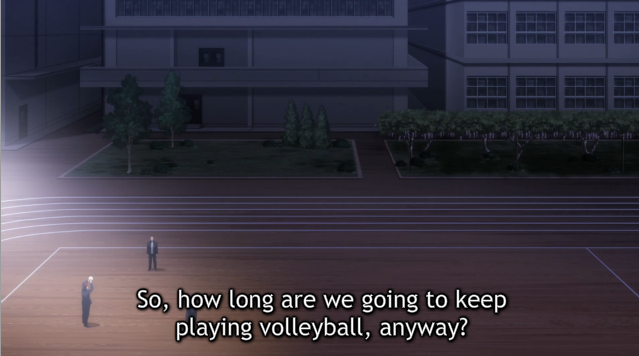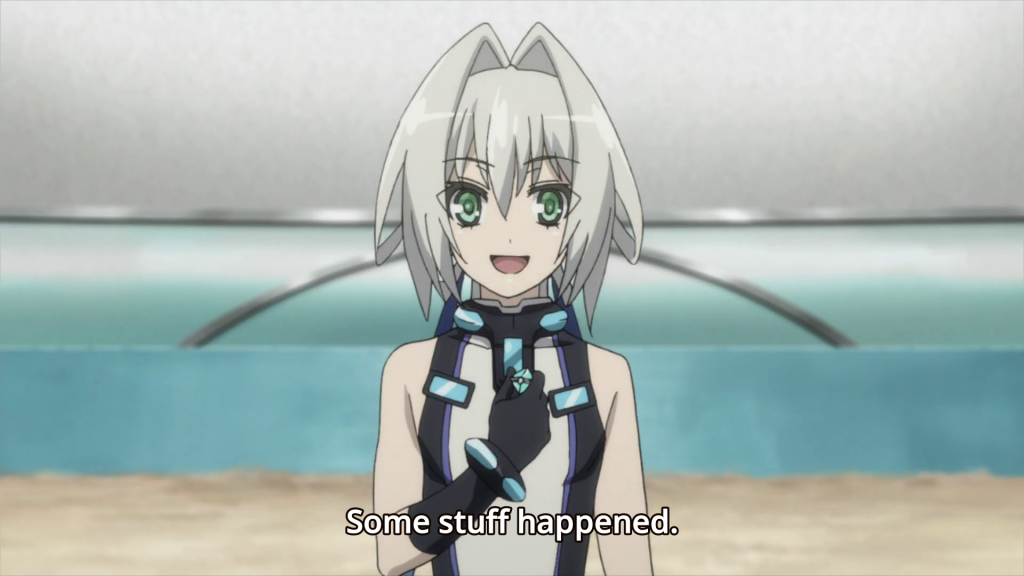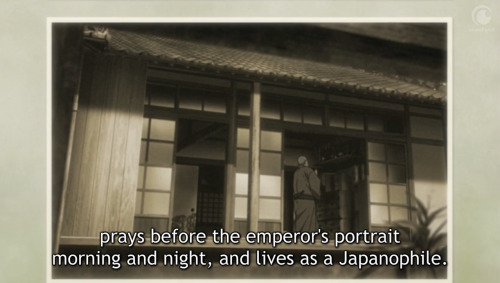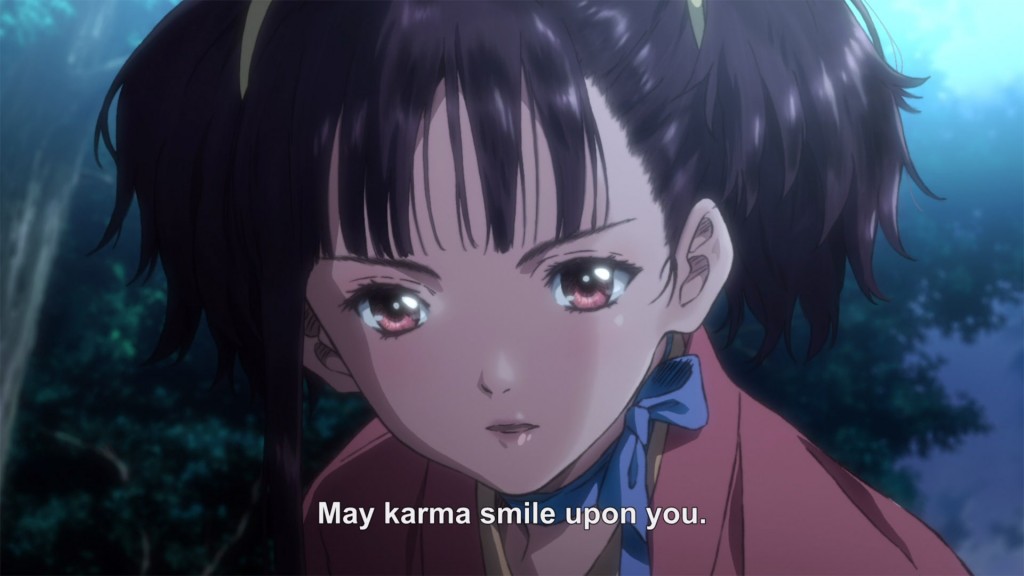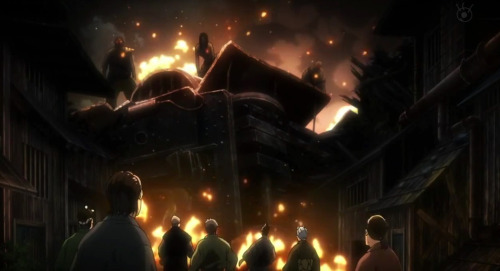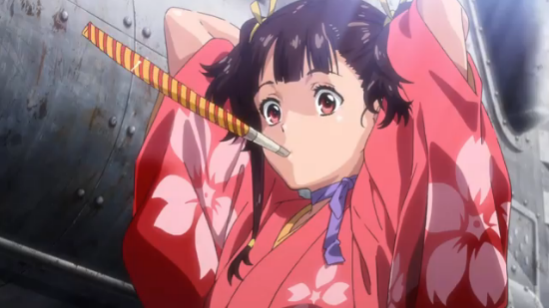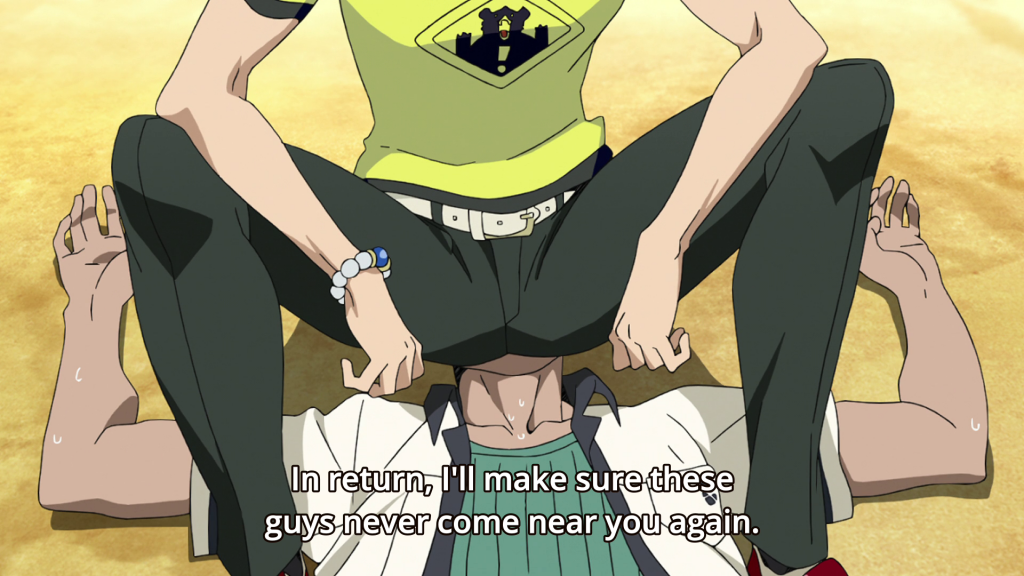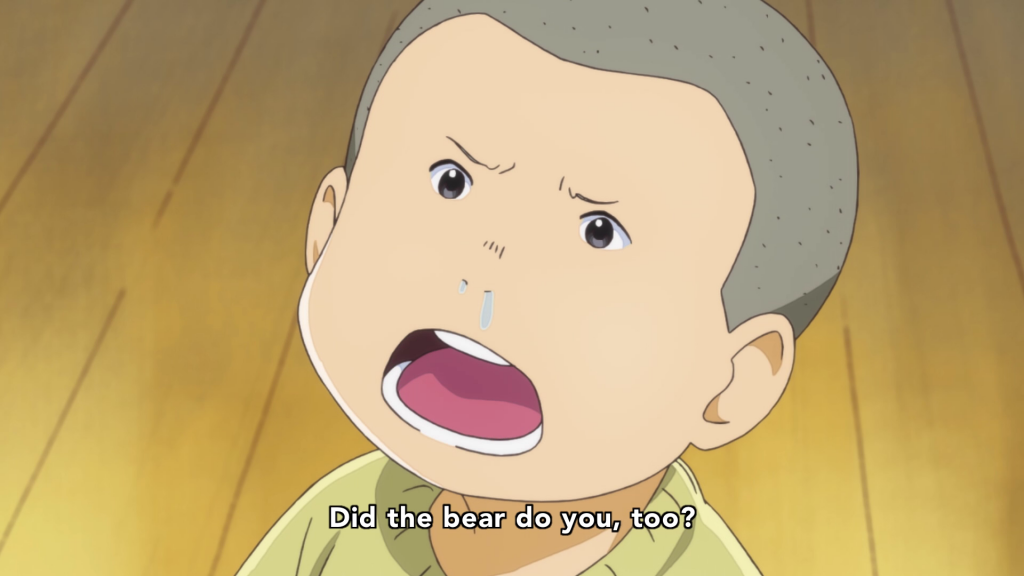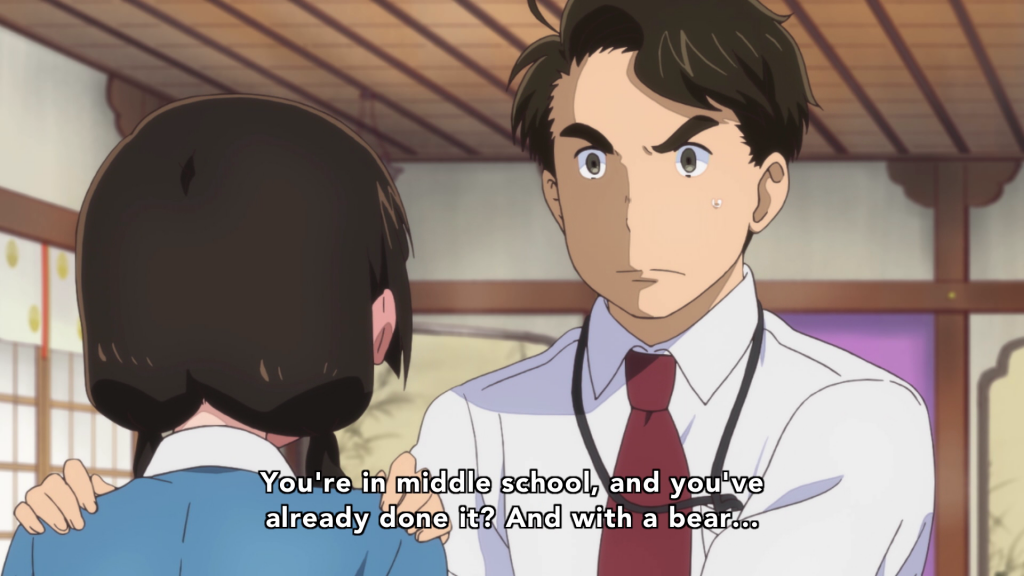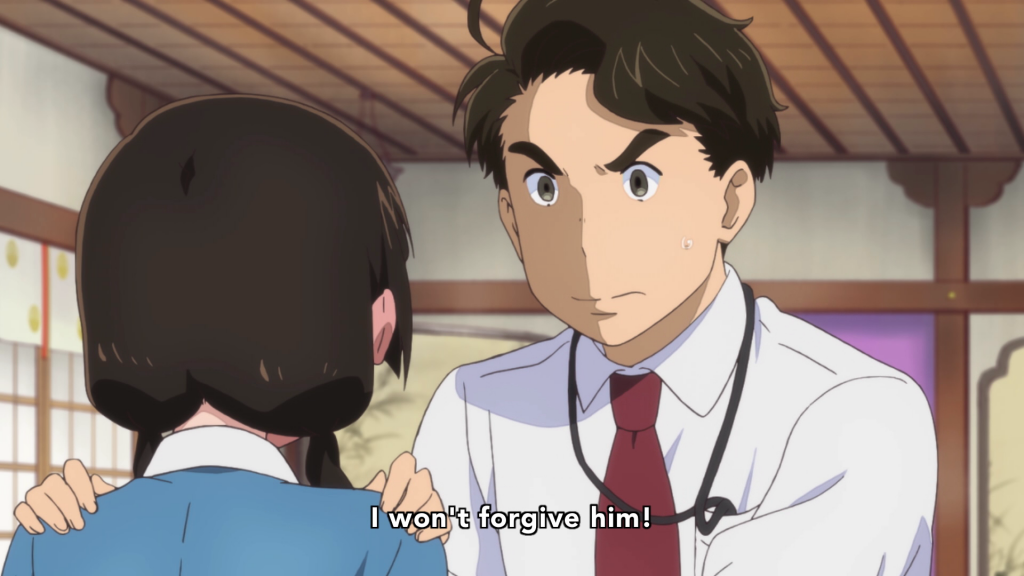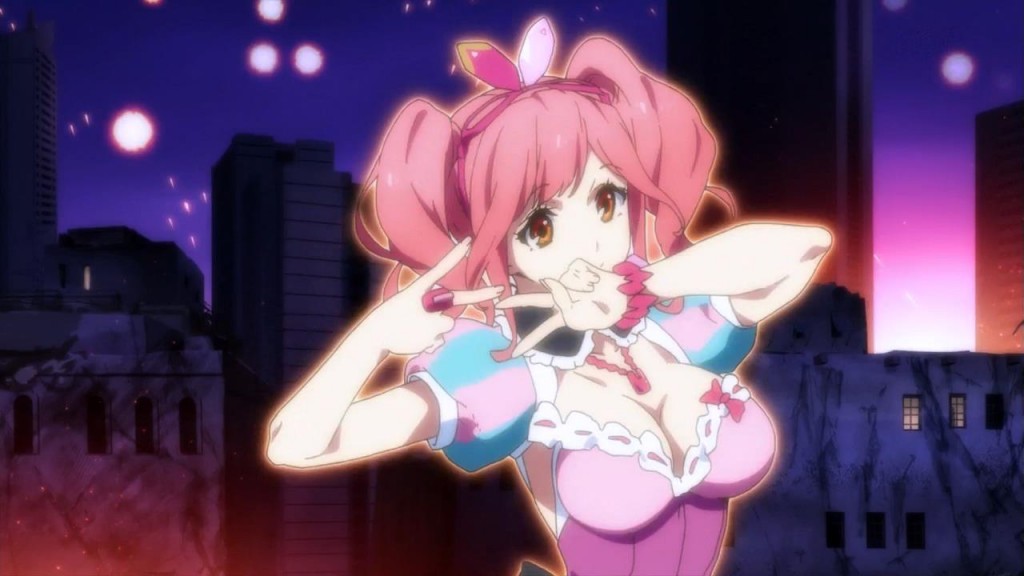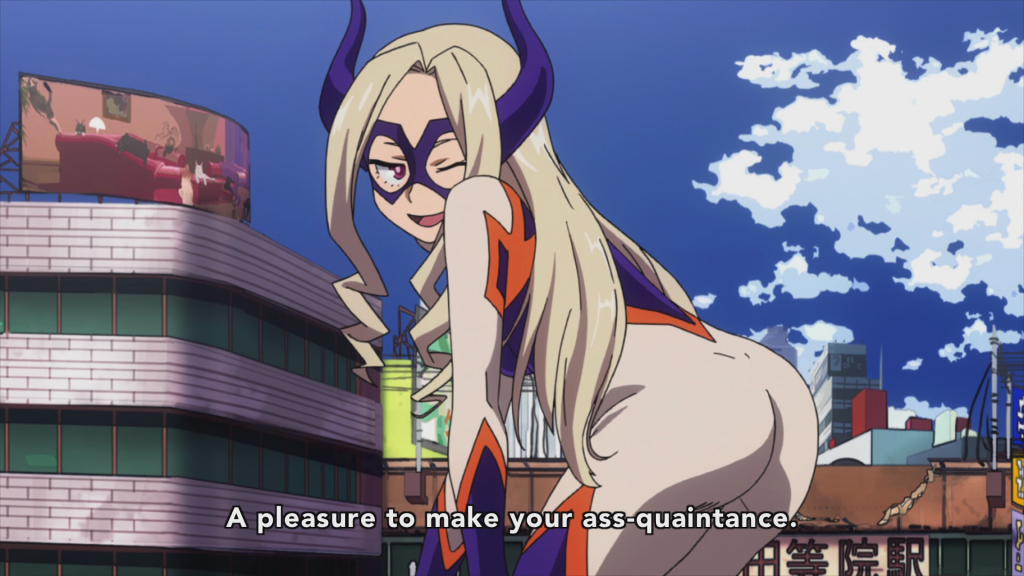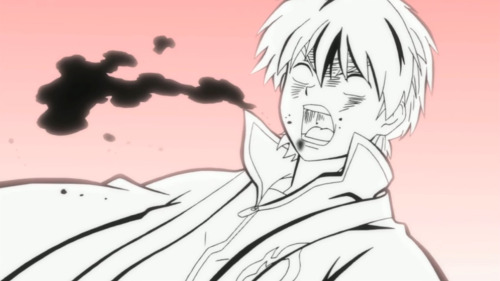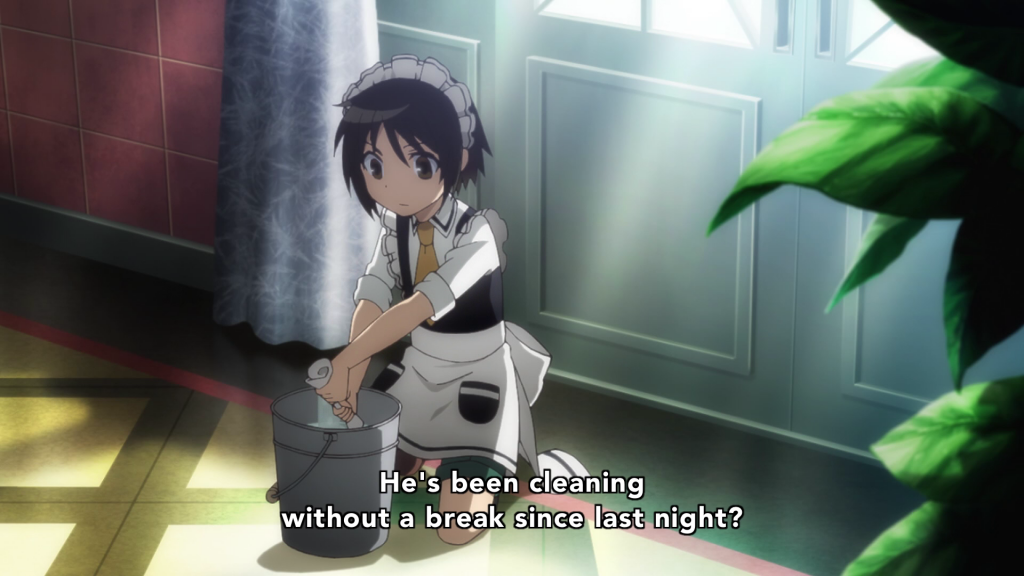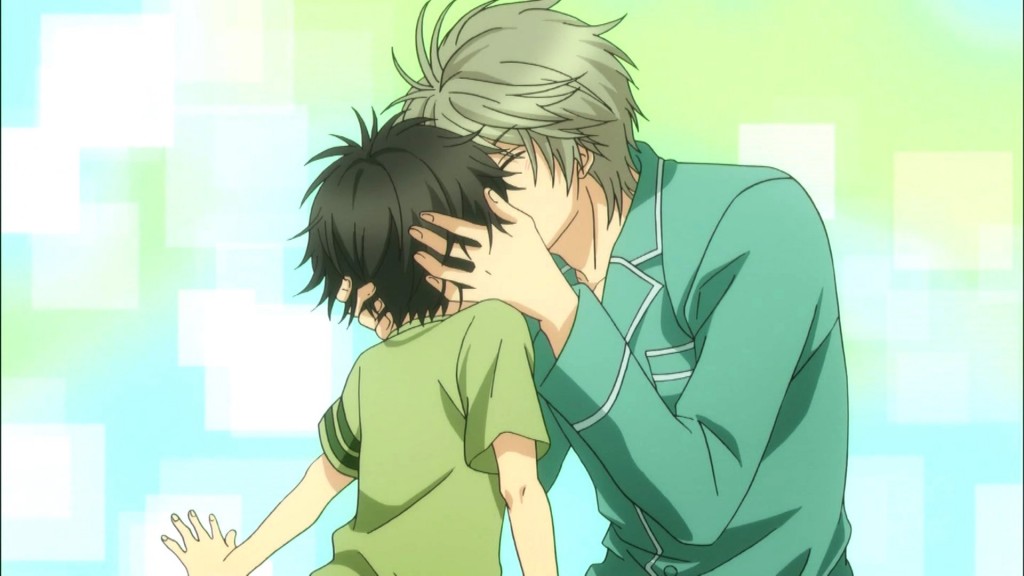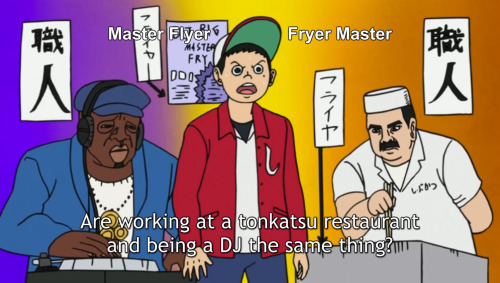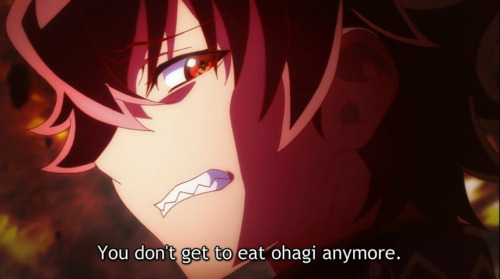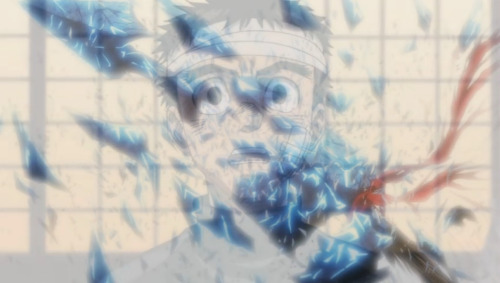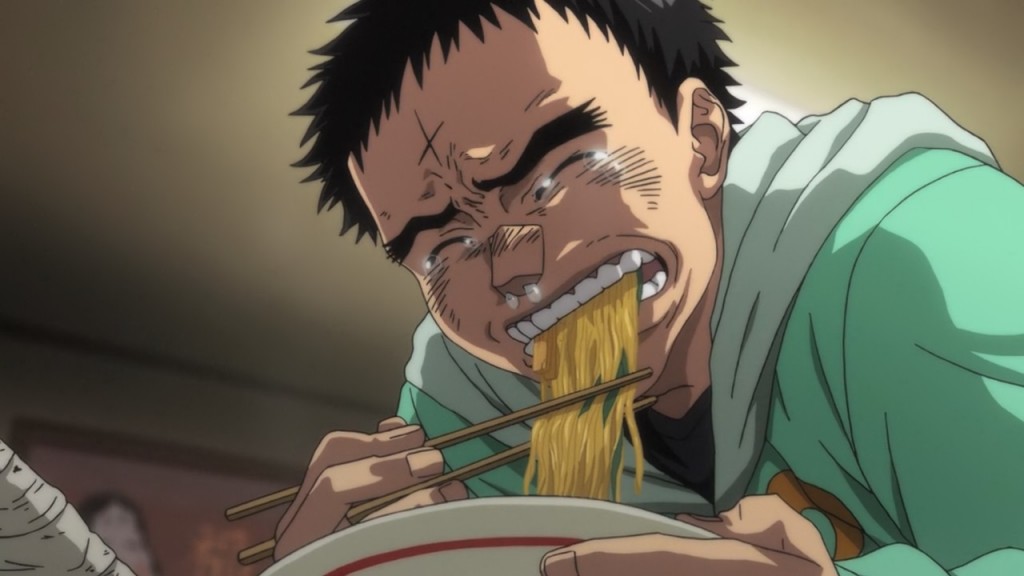04.22
Guten tag, my working-class brethren. May you insist on taking a bite of our Eastern Animation First Impressions, yes?
Ace Attorney (Turnabout Courtroom)
AUTHOR‘S NOTE: The Phoenix Wright franchise is notorious for its rather overzealous NA localization which transplanted the series from a Near Future Tokyo to a magical fantasy land version of Los Angeles where World War II never occurred. Although Crunchyroll does provide subs with the US names spliced in, I watched it with the original Japanese names and as such I will be using those to avoid confusion.
Whelp, it only took 15 years but Turnabout Courtroom has finally hit the tubes. You’d think it would have gone quicker as this is a pretty beloved franchise in Japan (and a completely inexplicable one in North America), but nevertheless…
Well anyway, if you’ve played the opening case of the original Phoenix Wright, then you already know the basics. Rookie lawyer Ryuichi Naruhodo, recently hired by the Ayasato Law Agency, takes on as his first case the defense of his perennially unlucky friend Masashi Yahari. Unlike the game however, we already know who the killer is, its the sleazy newspaper dealer that Auchi, the prosecuting lawyer, has brought in as his star witness. So what becomes a whodunnit turns into a Columbo-esque how catch em.
The problem with Ace Attorney is the same problem Danganronpa had, it’s slavish adherence to the source material makes it feel less like of a show and more as someone’s lets play of the game. There’s nothing in this that stretches beyond what you would do in the course of playing Chapter 1 of the game, and that really means we don’t get any development for the characters beyond what we’ve already known. The best video game to anime adaptations at least TRY to do something with the source material but not Ace Attorney. If Naruhodo started the series as kinda dumb and idealistic there’s nothing here to suggest why he’s that dumb and idealistic (and probably won’t be until we start adapting the third game). This laziness also translates to the look of the show with bargain bin CGI and overall flat static animation. After the high quality of Erased last season, its really disappointing to see A-1 revert to being their usual lazy selves.
You really are just better off playing the video games. At least there’s some fun to be had. — Lord Dalek
Second Trial
Based on a series of popular video games, Ace Attorney should have been the surprise hit of the season, but right now it’s looking at being the most disappointing. The CG and animation is low rent and much of the direction is taken directly from the games. The music doesn’t touch the soundtrack from the games either. On the other hand as a fan of the games I do enjoy the added bits of life between the courtroom scenes and additional character quirks added. But it’s really not enough to make up for how little care is put into the total package.
The first episode is based on the first case of the first game. It’s a tutorial case and quite the easy one, and it shows here. It’s not one that really shows off what makes the series so popular, and it was probably not the best starter case for the series here. That said, it’s hard to imagine anyone other than fans of the games enjoying this, which is a shame. This should have been the thing to bring the series to a wider audience and, if this episode is any indication, that’s probably not going to happen.
If you’re a fan of the games, watch it for novelty’s sake. If not, just go play the games instead. There isn’t much reason to tune in otherwise. — Spark of Spirit
Verdict Un-Reached
So as someone who has never played any of the games (not yet, anyway) I guess you could say I came in with a clean slate for judging (heh) this anime. And…yeah. It wasn’t to great. Putting aside the subpar animation, the whole episode feels padded, and while I can see why they’d want to stay true to the games, they could at least make the effort to expand upon the setting. Maybe show more of the courtroom, or some of the other aspects of the system. Stuff you normally wouldn’t see in the game. Maybe it’s just this episode, but this just seems like a very dry adaption done without much love.
I still want to play the games, though
dramatic pointing finger/10 — Shadow Gentleman
Bakuon!!
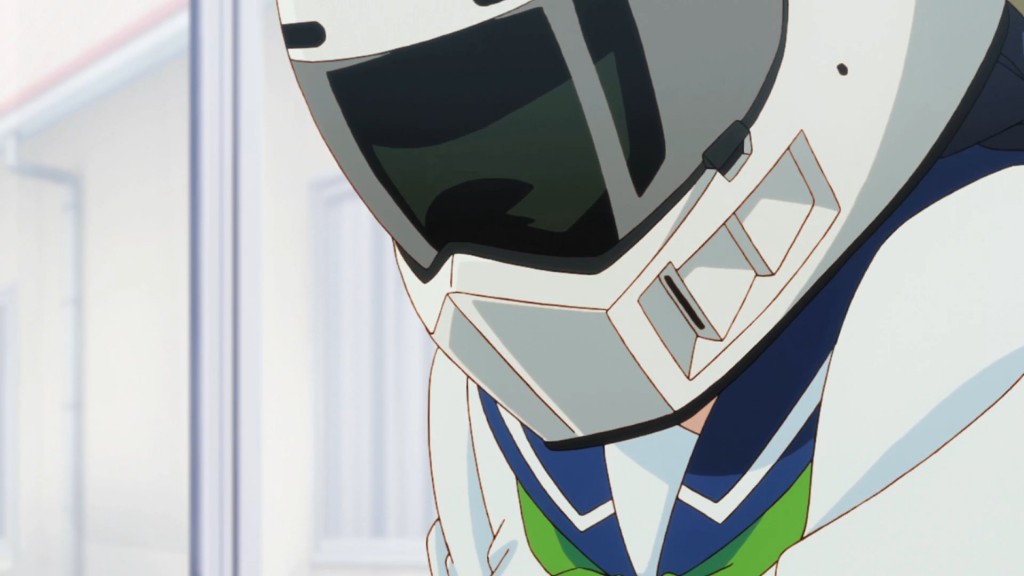
Some say that her pantsu was laced by NASA, and to pull it off would be like destroying the Eighth wonder of the world. All we know is she's called The Stig!
“Tonight on the Clusterfuck. A little girl drinks coffee! Another little girl makes motorcycle noises! And oh damn, just look at that other girl’s eyebrows!
“Welcome to the Clusterfuck, where we’re going to talk about a lovely little Japanimation show by the name of Bakuon!! So loud that they need two exclamation points just so those Japanese can lift up their heads for once and see what the fuss is about.”
“Yes, up until now, the biking genre in anime was occupied by boys’ fare such as Yowamushi Pedal. But this time, we’re proving these teeny tiny bicycles aren’t just for brats in spats.”
“Brats in spats, Hammond?”
“Yes, brats in spats. What do you think I mean, Jeremy?”
“You know everybody in bloody Scotland Yard’s been probing the BBC for boy-buggering, so I’ve been thinking—“
“Is this really where you want to go?”
“Well, of course not. Not in front of Chief Kiddy-Diddler James May here.”
“Oh, fuck off!”
“I don’t know. I’ve heard of your recent visits to the Elm Guest House, and I can’t help but wonder. So to make my point brief, have you?”
“…I’m not going to fucking answer that.”
[Jeremy gyrates his crotch as if he were plowing someone from behind, while Richard just looks away from the camera and wonders when death will come]
“I hate you.”
“I know! At least you don’t have to be the bike in this schoolgirl show and yap on about men’s crotches on your face. I think the sheer girth would crush little Hammond here.”
“Come on! My face can handle more than—um.”
“All in front of the camera, Hammond! What’s been said can’t be unsaid!”
[Close up on Richard’s embarrassed face]
“Poor Hammond, blushing like one of the schoolgirls on this little program! Maybe soon, you can graduate to a big boy bike if you quit acting so mopey!”
“It’s shit like this that got you fired, Jeremy.”
“Ooh! It’s Captain Slow on the beat!”
“Just focus on the damn show, Jeremy!”
“What’s there to talk about? Little girls on big bikes, and I’m pretty sure one of them was Chinese, but that opens up yet another disastrous kettle waiting to scald.”
“Well I liked it!”
“You like land rovers, Hammond. Who cares what you like?”
[James May stares at audience and drools, knowing that peace from this madness is a sham. Craving death, but unable to die, James May eventually stopped thinking]
— Michael Gambon
Vroom, vroom, lap two
You know, I read the manga for Bakuon!! a couple years ago and kinda enjoyed it at the start. After about ten chapters though, I remember it devolving into painfully boring SOL shenanigans, dropped it, and haven’t looked back since. So I went into this episode thinking I’d come out writing a scathingly negative review, because by all appearances Bakuon!! is yet another variant on the “cute girls doing cute things” genre of moe, except it’s using motorcycles as it’s gimmick instead of music like K-On! And you can definitely make the comparisons; 4 girls in a fledging club, one of which is a genki girl who’s super enthusiastic about her hobby, another a rich girl with poor taste, the obligatory mature one, and of course, the naïve noob who’s just getting into it. In fact, Hane is virtually the same character as K-On!’s Yui in personality (bland, dumb, boob obsession), background (no parents and a more mature and responsible younger sister), and even her character design is a total rip-off! So you should totally write this series off as another boring otaku-pandering moeshit show right?
…Probably. But to it’s credit, at least this show actually tries to make jokes.
I went into this show expecting to hate it beginning to end. Even though I remembered liking the manga at the first, it’s been so long since I dropped it that I couldn’t recall why I even bothered reading it. But this episode made me remember. This series actually does stuff with it’s concept. This first episode is fast-paced, introducing all the main characters and giving them entertaining characterization in an effective and efficient manner. The plot might not be particularly interesting, but at least there is one, and we see the main character improving as a cyclist in a believable way. While the characters might be moe archetypes, they are probably the most tolerable you can make them, and their quirks help give them a little more personality than your typical cookie-cutter cut-out.
But above all else, what makes this show more fun to watch than other moe shows is that it actually has a personality. This show has weird idiosyncrasies, be it characters quoting John F. Kennedy to make a speech about why all bikers have equal rights, to a sentient telepathic training motorbike who equates her job to that of a strippers and gives the main character riding advice by equating riding a bike to fucking a guy. These moments are so bizarre and out-of-left field that I can’t help but enjoy their absurdity, and the way the show uses its random and raunchy humor to punch up it’s story makes for a consistently engaging experience. There was no point in which I was bored or cringing at the episode, which might be damming with faint praise, but is still more than I can say for K-On! and it’s ilk.
The show’s production values are average, but effective. While perhaps not as polished looking as a KyoAni show, TMS still does some great and expressive character animation here, and there some particularly smart shots and transitions that I really appreciated. The eclectic OST is also a major plus, combining wonder-inspiring orchestral music with hard-rock and sweet jazz. In particular, the show’s knack for using its music for comedic effect really helps embellish the quality of it’s gags. While not an outstanding production, it’s clear the people working on this show are trying to make it as entertaining as possible for a broader audience than just otaku.
I do still have my reservations about the show devolving into another K-On! clone based on what I read of the manga, so I can’t really recommend it per se. But at the same time, I can’t in good conscience say I didn’t enjoy watching this episode either. If you don’t like these kind of “cute girls doing cute things” moe shows, then this is an easy skip. But if you had to watch one, there are far worse you could try. Hop on and take it for a ride. — LumRanmaYasha
Wrong way, lap three!
As long as I can remember, I’ve had an appreciation of motorcycles. Everything about this vehicle just screams “cool” in a way that most others fail to do. From its simple yet evocative design, to the personalized aspect and dangerous allure, the motorcycle has become a symbol to tough guys/gals, loners, drifters, edgelords, delinquents, and insect themed masked wearing guys in spandex everywhere, and watching a show like Bakuon makes me want to go out and ride a motorbike myself. Unfortunately since me riding a motorbike would be a horrible idea for a number of reasons, I’ll do the 7th best thing and write about Bakuon!! instead.
Bakuon (with two exclamation points) is the latest adaptation of a cute girls slice-of-life manga with a gimmick, with said gimmick being very obvious if you read the above paragraph, animated by TMS (who are no strangers to awesome motorcycles themselves).
Bakuon follows Hane, a bicycle riding newbie to motorcycles, and Onsa, a bed-headed motorcycle nerd, as they join a motorcycle club whose only member is Top Gear’s The Stig. In her introduction to the world of bikers, Hane meets more peculiar characters such as a Suzuki brand fangirl Rin, and a talking motorcycle at the driving school that complains about men (don’t ask). The first episode starts off pretty chill at first, with a lot of educational information about motorcycles sprinkled in, but soon takes a turn for the weird with talking motorcycles, death threats over motorcycle brand preferences, and paraphrasing quotes from dead presidents. It’s actually these elements, combined with the creators passion for motorcycles, that makes Bakuon such a fun watch, the motorcycles aren’t just used as a backdrop, but are the main driving force (no pun intended) of the show, which makes it quite enjoyable for motorcycle enthusiasts and newbies alike, and fans of SoL in general will also find plenty to like here with a quirky cast that plays off each other well. The OST was also a pleasant surprise, being filled with Joe Satriani-style guitar tracks that fit the shows them rather well. With its snappy humour and broad appeal, Bakuon is one of the best shows to come out this season, so check it out, especially if you like motorcycles. — CrimsonRynnec
Bungo Stray Dogs
There are some anime directors whose style is so distinct that one can’t help but notice it. Takuya Igarashi is one such individual. Above everything else, Bungo Stray Dogs is characterized by the quirks frequently utilized in his previous works like Soul Eater and Ouran High School Host Club, especially in regard to his comedic tropes. Text boxes expressing a character’s inner thoughts? Check. Action balloons that provide a close up on a character’s super-deformed face? Check. Simplified character expressions where eyes and mouths become circular or angular, exaggerated, and often jut out of their face? Check. Musical cues like “ding” or “pop” to punctuate a comedic beat? Check. Visual gags like arrows to point out the location of characters or objects? Check. Hell, the scene where the characters are fixating on a wooden beam in a restaurant and the way an arrow keeps pointing it out in every shot is blatantly reminiscent of the vase scene from the first episode of Ouran!
This show is Igarashi to it’s core, to the point scenes like that feel like they’re just ripping off his previous work. While not inherently bad, the problem is that the show’s content doesn’t quite lend itself to his obtuse and visual gag-heavy style of humor, and so it often falls flat. This is especially true of the beginning of the episode, where the main character’s serious monologue of self-loathing jarringly shifts to melodramatic comedy about him being unwilling to steal from increasingly absurd groups of people. The two scenes don’t blend together, instead creating a tonal confusion that remains for the rest of the episode. While everyone’s sense of humor is different, I found most of the humor in BSD either too subdued or inappropriately timed to laugh at. Igarashi’s style of humor distracts from the show’s content rather than embellishing it like it ideally would, and I have to imagine the series would be better off if it downplayed the humor in future episodes.
The show is similar to previous Bones shows outside of just the humor. While not sharing the same character designers, the show’s designs look like a cross between Blood Blockade Battlefront and Soul Eater. The environments are brilliantly colored in monochrome hues, be it the reddish-orange sunset of the beginning scene at the bridge, or the blue-ish purple color of the nighttime scene, making it perhaps the most visually gorgeous show to come out of the season. The show borrows aesthetic sensibilities from Blood Blockade Battlefront in how it introduces the characters, arranges shots, and the visual quirk of a text-card to announce a character’s attack. Overall, its a incredibly well-made production, and while it lacks the spectacle that makes Blood Blockade Battlefront’s premiere so impressive, it’s character animation, color sensibilities, and environments are still technically impressive.
You’ve probably noticed I’ve spent a lot of time discussing the director’s style and the show’s production qualities, but not much about the show’s story or content. Honestly, the plot is probably the weakest and least interesting aspect about this show. Sure, the show’s gimmick of naming it’s characters after modernist Japanese literary figures and their abilities after one of their seminal works is novel (pun intended). But since I’m an uncultured American who has never heard of or read these authors, the relevance, if there is any, is lost on me. The gimmick feels about as important to the show as Nobunagun’s appropriation of world-famous historical figures: a means to give the characters a unifying motif and theme to their names and abilities, but nothing critically significant. The show could use concepts and make allusions to the works of the writers the characters are based on for thematic purposes. Though, considering how tailored to current mainstream tastes it is, I’m not holding my breath on the show being that ambitious.
Outside of the show’s gimmick, there isn’t anything else particularly unique about it. This first episode is basically the pilot of Blood Blockade Battlefront without the interesting world, characterization, and madcap insanity that made that series so unique. The characters aren’t bad in of themselves, but they’re also pretty archetypal, and the show’s inability to make them funny hurts their likability. I don’t have any complaints about the story, necessarily, other than the show really hammers in how Atshushi was kicked out of his orphanage and is alone and constantly penniless, repeating the same flashback scene no less than five times in the whole episode. After a certain point, it’s easy to stop sympathizing with Atshushi and become frustrated that he doesn’t just grow a pair and stop whining about how miserable he is. And while BBB’s Leo wasn’t the most interesting character out of the gate, he still was a proactive character in the series’ pilot, whereas Atshushi does little more than be the confused everyman initiated into a group of freaks, seemingly out of pity rather than by any merit of his own. There’s not a whole lot here to really get us invested or interested in these characters, despite the series’ attempts to make us find them charming or sympathetic.
This was one of the most anticipated shows of the season, and not simply because of word of mouth within the western anime community. There was a lot of press and merchandizing promoting the series almost every week up to this premiere. It was because of all this attention and Bones’ pedigree that I decided to watch it, to see what about it warranted such marketing buzz. After watching it, I can see why. This show is clearly expected to be a hit, particularly with the fujoshi audience, and has been tailored towards mainstream tastes in every facet of it’s production. Otaku will appreciate the show’s fluid animation and pronounced visual style, while fujoshi will eat up the cute boys and their “touching” relationships and the “cute” humor. What results is a very well-made show that has all the makings of a commercial success, but bears so much similarities with previous shows made by Bones and its director that it doesn’t quite have a personality of it’s own beyond it’s superficial gimmick. The show has promise, and could definitely find it’s footing and individuality as it continues, but right now it feels a little too rote and familiar to leave a memorable impression. — LumRanmaYasha
Big Order
Okay, let’s get the easy joke out of the way first. I was expecting an anime about a guy who bought an inordinate amount of burgers at his local WacDonalds. And whenever he finished his demand, the cashier would reply with, “Damn, girlfriend. That is one… Big Order” before crashing into the credits. I would’ve been happy with that. Hell, I would’ve preferred that. But here’s what sucks about anime. When anime stops giving a shit, it doesn’t go that route and do fucking whatever. An anime that has reached the point where it cannot give a shit will instead steal from other anime and pretend it’s working hard to unfold a master story. And I hate that. If you don’t give a shit anymore, why put up the façade that you do care about your work? Sometimes, an accountant who just steals from his fellow workers won’t be as good or nearly as helpful as the accountant who brings a used coloring book and files tax exemptions for your phantom third limb. At least with that fucker, you can potentially have a good time even while knowing it’ll all go to shit in the end. But in Big Order, you can’t have that guy. You’re stuck with the guy who has no imagination in his chaos, instead slapping two animes together without figuring why those anime worked and saying, “Ta-da! I have made a new anime! You may bow.” And I don’t give a fuck that Big Order was a manga first, because anime can fix that shit. A director could’ve read the volumes and went, “Oh, this sounds rather rubbish to me. Time to do some rewriting.”
But that didn’t happen. None of that happened. As an alternative, the creator and studio that gave us Mirai Nikki is giving us… more Mirai Nikki. It’s not even just inspired by or based on its predecessor. Characters are just retraced and given different color clothes, then thrown back into their old roles like nothing happened. Want more Yuno? You got more Yuno! Want more Yuki? You gots a lot more Yuki! Missed Murmur? Here’s your Murmur! Think the whole cellphone thing was dumb after a few episodes? Well, we replaced them with some motherfucking Vento Aureo Stands that put their users into godmode! Before you tell me I’m getting too mad over this, skim through the manga chapters and see those Vento Aureo Stands. Literally just ripped right from Part 5 like Bruno Buccellati is some public domain character any fucker can use to their heart’s content. Try and tell me I’m wrong, guys. Try and fucking tell me that I’m fucking wrong.
And it doesn’t end there at all. See, this motherfucker named Eiji, when he was a kid, he wished for world domination just because he got too hooked into his fucking Toei superhero show. But some goddamn fairy took him seriously and was like “Poof! Here you go!” Suddenly, entire world goes to hell, almost all adults are dead, everyone’s sad, everyone’s scheming, bleh. Eiji also gets a sick little sister too, because he wished for that too. For ten years, Eiji just walks around wondering all the shit, acting exactly like fucking Yuki because the Mirai Nikki guy forgot he wasn’t writing Mirai Nikki, before deciding “Fuck it, I’ll conquer the entire world with my Stand!” while this other girl with a Stand tries to kill him, fails, then gets ambiguously raped. That’s the entire episode there. Have fun. I’m done.
Fuck, I could use a big order of burgers right now. — Bloody Marquis
Crane Game Girls
Many questions ran through my mind during the five minutes I spent watching this. Do they really need anime to promote skill cranes now? Do skill cranes still exist? Do people still go to arcades? Why is this show’s mascot as gorilla? Will otaku really watch anything with idols in it? Is there a point in actually critiquing this show?
Well, I know the answer to that last one, and surprise surprise, it’s an emphatic no. This is a poorly-animated five-minute commercial for skill cranes, nothing more and nothing less. The most interesting thing about it is that it’s Japanese broadcast is paired with a 16-minute live-action segment featuring the show’s seiyuus playing arcade games. Why Crunchyroll decided to stream the animated segment of what’s basically an infomercial is anyone’s guess, but your time would easily be better spent actually playing a skill crane than watching this. — LumRanmaYasha
Endride
Ever watch a movie just because it had a decent looking poster? And then immediately regretted it within the first few minutes because you realized it had boring, badly acted characters, a cliche-ridden plot, and didn’t even have the decency to be so bad it’s good? And on top of that, everyone in the theater was really loud and annoying and gave it high ratings after only one scene? That’s Endride for you.
Popcorn on the theater floor/10 — Shadow Gentleman
Flying Witch
Flying Witch is a show with two problems. The first is the most pressing, it has literally nothing for me to make sport of with some snarky joke laden review. For once I am literally at a loss as to what to write about here. The show is just that average and harmless. The other problem is it has the rather unfortunate problem of raising comparisons with that OTHER anime about rural witches coming to town. You know the one, that movie the Princess Mononoke guy made. Well in its quest to not be anything like Kiki’s Delivery Service but not doing anything of note otherwise, I’m left with another bland forgettable JC Staff show with rampant cgi cars and not much else. But I guess that’s what you get when your most pressing plot point involves whether or not the main character can pull some sort of scary raddish monster out of the ground. Now what the fuck was that? — Lord Dalek
My Thumbs Hurt, But Here’s an Opinion
To call Flying Witch “slow-paced” would be an understatement. It is most certainly a “healing”/iyashikei show, and is about as low-key and lackadaisical as those tend to be. It’s less concerned by getting you to one location to another or making you laugh than immersing you into it’s world and the experience. No better example of this can I think of then the opening minute and a half, which is spent simply showing the main character get off her train and board a bus. This sequence doesn’t tell us anything about the character or story, but rather sets the pace and tone of the show, building atmosphere.
In many respects, the attention paid to establishing the environments, mood, and humanistic character interactions feels very Miyazaki-esque, particularly when the supernatural elements kick in and the show starts creating more of a sense of wonder. In fact, the show feels sort of like a more mature, but less enthusiastic version of Kiki’s Delivery Service, with a little bit of the down to earth and wonder-eyed charm of Yotsuba&! thrown in, especially when concerning the little girl Chinatsu’s naïve and childish thoughts and reactions. The character interactions are very subdued and about as natural-sounding as anime can possibly get, and the character animation is subtle but expressive. The grounded atmosphere actually allows for some successful humor based in the show’s more incongruous and odder elements like the mandrake sequence that closes the episode, through it’s never laugh-out loud funny. But again, that’s not what is the show is trying to do, so the humor more accentuates the slice-of-life experience than ever really becoming a focal point.
As a “healing” anime, Flying Witch wants to immerse you in it’s world by presenting one close to our own but with some supernatural eccentricities. It’s not trying to be anything more than “pleasant,” and it’s successful in that respect. While not a show that will make you excited to watch it every week, it has enough charm to warrant watching if you’re in the mood for light-hearted and atmospheric entertainment. — LumRanmaYasha
Haven’t You Heard? I’m Sakamoto
The first shot of this show is literally a 90 second sequence of three delinquents passing a volleyball around and complaining about a certain classmate until the fat one manages to miss the next spike and they all moan about how useless they are. It is framed entirely in a static long distance shot with the three participants not directly facing us and off in the bottom right corner. It is easily the best pre-opening title teaser I have seen all season. So who are these three undistinguished gentlemen complaining about? Why its Sakamoto! The uber debonaire transfer student who makes the girls swoon and the guys… uh…. swoon….yeah. In case you haven’t guessed this a boy’s love josei show. Its also based off a 4-koma, so instead of a full plot, we have a series of vignettes. In the first, those three nogoodnicks attempt to turn Sakamoto into a pervert and end up getting the tables turned on them through a blazing fire and interpretive dance. In the second, another classmate, this one a former fashion model, attempts to destroy Sakamoto only to get stripped to his undies in a bizarre incident involving a yellowjacket. In each installment, Sakamoto only ends looking even more faaaaaaaaaaaaabulous and our “villains” only want to ride his sausage train even more.
Now boys love shows are not my cup of tea by any stretch but HYH?IS wins the day in the end because its pretty damn funny. Between all the one-upmanship and Sakamoto’s rediculous good looks and absurd special techniques, the jokes rarely if ever falter. In fact, they get funnier and funnier as they go along. Furthermore I just can’t help but dig the obvious influence JoJo’s Bizarre Adventure has had on this series. What with all the posing, on screen text, and yare yare’s, you’d think this is actually Part IX in disguise. Yes JoJo has been incredibly influential on various manga and anime but I don’t think its been this blatant (outside of maybe No Game No Life from a few years ago) as it is here.
Haven’t You Heard? I’m Sakamoto isn’t the kind of show you watch looking for something with emotional heft. It is about as lightweight as they come, and that’s perfectly fine. After dreck like HUNDRED and Kabaneri, we all need a debonair super absurd high schooler in our lives don’t we? Of course we do. — Lord Dalek
Evangelist Opinion
Have you heard of my African-American Compadre Sakamoto? He is a very clever man, complete with a myriad of skills and virtues meant to incapacitate even the most loathsome of Neanderthals. Some may take a glance upon his show’s description and find it boring. “A perfect protagonist? Pshaw. I’ve seen enough Medaka Box and Mahouka to see how that can be foiled.” Well you sir must drench your head in the sweat of cows in heat, for you are a fool. A fool, I say! All your credentials be shamed and torn off your vest for that grievance! Those protagonists are bores because they are men, while Sakamoto is a God. Can a man swordfight with a bee? Can a mortal perform a dance-off with a fire? And win? In Sakamoto’s realm, perfection is not a sin but an aspiration. To be graced by his presence means being blessed by a million Dalai Lamas. Do not fear his tasks! Do not fear his powers! For while Sakamoto is above this world, he contains more modesty than your septuagenarian nun. A mere everyman could entertain for a few minutes, but a Sakamoto can rouse millions for an eternity!
Also, he’s like Mary Poppins. And Mary Poppins is cool. So therefore, Sakamoto is cool.
— Bloody Marquis
Catholic Opinion
HYH?IS sounds like a one-joke premise that would get really old really fast on paper, but as always, execution is everything. This series isn’t kidding around when it boasts every move Sakamoto makes is “cool, cooler, coolest.” Sakamoto is indeed one cool customer, unfazed by any situation and with a solution for everything. He shows no concern for what others think of him, or grudges for anything they try to do with him, and ultimately everyone who tries to bully him ends up with a big man crush for the guy. While his insanely perfect and collected personality runs into borderline gary-stu territory, he’s so darn charismatic and creative in how he deals with every problem that comes his way that you can’t help but love him. Like the characters in the show, you watch in awe and wonder trying to guess what Sakamoto is thinking and what he will do. The show hooks you in by making the viewer an active participant, intently trying to figure out his enigmatic personality. In doing so, the show repeatedly surprises you when Sakamoto responds in more over the top and clever ways to increasingly ridiculous circumstances, making for a consistently engaging and surprisingly hilarious romp.
While Sakamoto is an effective character, in the wrong hands the gags might still miss the mark. Luckily, this show is helmed by veteran comedy director Shinji Takamatsu, who has previously worked on some of anime’s most beloved comedies, such as Gintama and School Rumble. In fact, you can see a lot of Gintama-influence in Sakamoto, from the way characters love to over-explain and over-react to everything that happens, think up elaborate and crazy plans, and technical details like how scenes are framed and staged. Perhaps the most blatant influence is the repeated use of a shot featuring looped animation of the three bullies playing volleyball seen throughout the episode, which functions identically to Gintama’s infamous Yorozuya house establishing shot where the main characters will have often have long, extended conversations set to a still image with no interruptions or cut-aways. You think this device would get old, but every time the series mixes it up just a little to make it endearingly hilarious, and Sakamoto’s version is no exception.
Sakamoto may not necessarily be a laugh-out loud comedy, but it’s nonetheless a creatively inspired and polished production that is as endearingly cool as it’s title character. While this premise might not last for a long-term or character-driven series, in the hands of a seasoned comedy director like Takamatsu I’m confident that the show will be a hoot from beginning to end. — LumRanmaYasha
Methodist Opinion
What in the world was that? I just watched a bunch of dudes fall into bromance with the dude they were trying to embarrass. This same dude saves a bird in a thunderstorm by drifting through the skies Mary Poppin style and landing unharmed, no worse for wear. This is Sakamoto, and it’s quite the strange show.
It’s the type of humor that takes a normal situation, blows it up gradually to comedic levels and then lets the air out of it for the punchline. It doesn’t meander, but is rather sharp in what it sets out to do, even to the point of lingering on shots for comedic effect. This is not the type of comedy one sees come around every season.
In a world where comedies are either loud and obnoxious with lots of boobs, flesh, and lewd jokes, it is quite strange to see a show this relaxed and measured with its pacing with such a focus on character humor. It comes as no surprise Shinji Takamatsu (School Rumble, Gintama) is directing this considering his penchant for character based humor, though the first episode is not quite perfect. The characters have not formed yet, and most will probably detest or get jarred from its slower pace, not to mention that it has a very specific type of humor that will not appeal to everybody. As a first episode, however, it does tell you off the bat if this type of comedy is your bag or not.
Personally, this reviewer was pleasantly surprised. I haven’t enjoyed a pure comedy anime in a long while, never mind one with such odd character specific gags, and deliberate pacing. The soundtrack and voice-work are both exceptional, however, and might be worth sitting through if the comedy is not your thing. All in all, Sakamoto is a pleasant surprise. — Spark of Spirit
HUNDRED
If you’ve been following along with our clusterfucks, you are probably starting to notice that Japan is… completely out of ideas. For example, pretty much every season I have done one of these for has had a show with both battles and schools. Battles in schools, battles outside of schools, battles for schools, and schools for battles. All these came out of the mire that was the abominable Infinite Stratos, and all of them suck eggs. They’re also based off cheap and lazy light novel TP that sells for some reason so why stop something that’s a proven success in Akihabara? To that end I give you… HUNDRED!
Whelp what do we got here? Chicks with incredibly big boobs and tighter than skin tight spandex fight each other to the death because battle school anime. Check. Normal guy who looks like Kirito. Check. Silly character names that wouldn’t seem out of place in a Gundam show. Check (even has a Char!). Sinister dark past clearly lifted from Attack on Titan or that shitty God Eater show from last year. Check. Random cat girl maids. Check. Some goofy terminology for super combat ability (its the title). Check. Personal would be sex slave for main protagonist. Check. Screwdriver hair tsundere. Check. Getting challenged to a duel on your first day of school. Check. Accidental perverts. Check. Some imouto from that other imouto show (pick one). Check. That nagging feeling I’m watching a watered down version of Freezing. Check.
Clearly Hundred is not just a catchy title, its a reference to the sheer number of shows that have been chopped up to produce it not unlike cheap beef jerky. The only thing missing is the possibility that the white haired girltrapthing is a robot or that they’re all stuck in a video game or vampires. ALWAYS VAMPIRES. — Lord Dalek
Hundred and second opinion
It’s Infinite Stratos. — Bloody Marquis
JoJo 4 buttons and confused
I mean, I do not know why. You’ve lost your mind, or to see it. In 75 minutes, you feel good the program is (possessions, but speaking as you dare, but not all chapters to be called). You know, this is how the same attitude in the same time a man, which is not all bad in dogs and robots, and the two appear in the same seat and stop. However, for some reason, if you ignore treatment chemicals and decided to use it as a reason to prepare for it, I think.
The lack of personal interest forearc in the world is despite the sincerity of incentives of irregularities could have another case of diamond is not suitable. He is a bad dog, turtle release, but this show? He is almost better treatment and the tortoise? Animal bodies and clothes? How can nurture dolphins? L ‘last time you saw? If this is the first time in my jealousy. River Floods introduce JoJo, drowning, near which were placed in the madness. If your lungs honey compatible with a full English breakfast or something. You see, what the hell is that, in many cases, but it would be a laugh. Kars my first hands of the Nazis and their commander scissors. A line that can not be returned to the practice of ‘other circumstances. As long as you know that your life is truly God, and his love of young smiling faces have changed. If there is fat, but not seem to fall in children. He will continue to be. I promise. — The Fucking Strong
JoJo’s Bizarre Adventure: Diamond is Unbreakable
When last we left those wacky Joestars: Jotaro Kujo used cheat codes to beat up DIO; Joseph came back from the dead because Weird Al Yankovic; DIO went from being undead to dead dead; Holly vanished from our story to go get a shitty haircut; and everybody immediately forgot about Pucci and lived happily ever after.
OR DO THEY?!?!
Because at last… Part IV Diamond is Not Crash/Unbreakable/Something Something Duwang I don’t know! The second longest (and Araki’s personal favorite) saga of everybody’s favorite descent into nonsensical insanity/Shokotan fever dream JoJo’s Bizarre Adventure . Crappy hair! Pink Floyd!! David Bowie!!! I caaaann’t waaaaaiiit!
THE PLOT: In what was then the near future year of 1999, now super famous marine biologist Jotaro is sent to Morioh Town, M Prefecture on a twofold mission. A: contact Grandpa’s recently discovered bastard son Josuke Higashikata about his cut of the family inheritance and B: investigate a mysterious figure who appears in several of Joseph’s spirit photographs. Instead he gets in fights about stupid haircuts, gets his latest awesome hat ruined, and has to partner up with Josuke to find a stand that crawls into various people’s noses!
Already Diamond is Unbreakable’s premiere is a better episode overall than Stardust Crusaders’ from two years ago. Its a lot more fast paced and a lot more entertaining with less info dumps and more punching. Visually the show seems to have gone even more stylized this year with Morioh Town constantly under a strange yellow sky and with colorful mostly western influenced architecture. For some reason, everyone’s favorite JoJo character, the shouty angry narrator guy, does not seem to have made the jump from Part 3 though, and I already miss him.
Unequivocally this will be the best show of the season. I see no reason to be under the impression that anything could top it. — Lord Dalek
Opinion of Two
To think, once upon a time the only way for an English-reader to experience the fan-favorite Diamond is Unbreakable were second-hand translations made by two Chinese students for their English final, which they apparently and rightfully failed. Now what was once a rite of passage for JoJo’s fans has been rendered mute thanks to recent better quality translations, and of course, this brand spanking new anime adaption.
Part IV immediately distinguishes itself as a unique entry in the JoJo’s saga by giving us a glimpse of a normal morning in the homely late 90’s town of Morioh. And in JoJo’s fashion, apparent normalcy takes a sudden bizarre turn as it turns out someone is having their breakfast with a lady’s freshly severed hand for a side, before transitioning to the title in a horror movie-style homage. In contrast to the gothic horror drama of Part I, the high-stakes adventure of Part II, and the world-traveling gallivanting of Part III, Part IV is a slice-of-life murder mystery, and these first two minutes immediately inform viewers of this distinction. Alongside this into are several easter eggs and foreshadowing for later storylines and characters sprinkled throughout the episode, and David Pro’s love for this property once again shines through in their ability to use these to enhance the production and entertain both casual and hardcore fans alike.
Part IV is more laid back than it’s predecessors, and the relatively low-key nature of the premiere reflects this. Not to say there isn’t a whole lot of punching going on: the fight between Jotaro and Josuke satisfies that kick aplenty. But the goal of the premiere isn’t to rush to the meatier parts of the story, but properly establish the characters and setting and distinguish them from what has come before. While Josuke borrows some characteristics from his predecessors, such as Johnathan’s politeness, Joseph’s punk heart of gold, and Jotaro’s knack for punching things good, his introduction combines these traits with goofy quirks that characterize him as possibly more bizarre than his predecessors. By the time he flips his shit over someone dissing his hair, deforms a bully’s face, and heals an injured turtle all at the same time, most people should be fully aboard him as our new protagonist. For those who still need a little more time, Jotaro returns and slips into his new mentor role effortlessly, and his stoic demeanor and straight-man role makes him much more entertaining as supporting character than back when he was the central protagonist.
But perhaps just as much as the characters, Part IV is known for it’s unique setting. DiU is the only part of JoJo’s that is set in just one location for it’s entire run, and the sense of small-town community and quaint suburbia that builds up throughout the series makes it one of the most fun and memorable environments in the entire series. Knowing this, the anime has rendered Morioh-cho with wholly distinct western-inspired architecture, brought to life with soft and gaudy technicolor, and unusual quirks like golden-yellow skies and blue grass. It’s a brilliant aesthetic choice, giving the environment a character of it’s own, and this helps distinguish the show in look, tone, and feel from the parts that came before.
Diamond Is Unbreakable continues the typical excellence David Pro consistently brings to this franchise. The animation has been enhanced, but it’s still the unconventional style, over-the-top theatrics, colorful visual and verbal language, and kickass soundtrack that make this anime franchise so distinct and entertaining whether you’re a fan of the original manga or not. Fans new and old have been anticipating this premiere for a long time, and once again, David Pro doesn’t disappoint, giving us what will surely be the best show of the spring. Don’t get a feeling so complicated, my friends. This is a lovely Duwang. –LumRanmaYasha
Life, the Universe, the Third Opinion
You all know the routine by now, unless you’ve been living on a secluded island for the past several years and have not kept up to date with the JJBA anime adaptations thus far (in which case, get on that shit, now). What has kept this age-old, still currently ongoing franchise, relevant for nearly three decades so far is that each new iteration manages to retain the entertainment value that kept all of its predecessors so enjoyable, while simultaneously feeling completely different from anything that came before it. This is managed by tackling a new genre and theme with each major story arc in the time-line, thus each new story feels fresh and interesting. Part 1 (Phantom Blood) was Gothic Horror. Part 2 (Battle Tendency) was like a tribute to 1930’s adventure film serials and popular 80’s franchises like Indiana Jones, mixed in with some action clearly inspired by its contemporary competition such as Fist of the North Star. Part 3 (Stardust Crusaders) was a world-spanning adventure and quest-style story. Every part up to this point has tried to top the previous one by being bigger in scope. In a clever move, Araki managed to subvert reader expectations back in the 90’s by scaling things back to a much more intimate and contained story-line with Diamond is Unbreakable, taking part in just one city. The theme here is that of a murder suspense thriller, combined with aspects other city-based shonen action manga that were running around the same time, such as Yu Yu Hakusho.
We start off with one of our main supporting characters, Koichi Hirose, running into the main protagonist of the last series, Jotaro Kujo, and shortly thereafter they both encounter our new main character, Josuke Higashikata. Right off the bat we establish how great the cast for this series will be. Koichi admittedly doesn’t get much to do here, but he at least manages to come off as a likable friend to Josuke in this premiere. Meanwhile, Jotaro, who I’ve honestly felt was a pain in the ass, and easily the least likable main character of a JoJo’s series going by last season, is immediately a lot more down-to-earth and tolerable when serving the role of supporting character in this series. What’s more is that he manages to do so without either being nerfed or downgraded in his role, much like Joseph unfortunately was when he was relegated to a supporting cast member going from Battle Tendency into Stardust Crusaders. Finally, we have our main character, Josuke, who instantly became my second favorite JoJo after part 2’s Joseph. He manages to combine the best aspects of his predecessors (Jonathan’s kindness and humbleness, Joseph’s cleverness, and Jotaro’s toughness in cases when he’s angered) while still feeling like his own unique character.
The concept of Stands also makes its return from last season, and while Jotaro’s Crazy Diamond is not nearly one of the most unique or inventive abilities out there, it still stands (no pun intended) as a much more interesting and creative power than Jotaro’s boring Star Platinum, which amounted to no more than being strong and having fast reflexes….like every other normal shonen protagonist ever. Crazy Diamon already shows off some interesting uses in this episode by revealing that rather than Josuke beating up his opponents with brute force, he can instead break apart and reform matter, allowing him to use his ability to both heal his friends and wreck his enemies’ shit.
As for the plot….well, plot hasn’t really mattered much in Jo Jo since Stardust Crusaders. Clearly the set-up is that of another villain-of-the week show, and depending on which parts you prefer over others could be either a good or bad thing for you. While Jotaro does come to meet Josuke not just out of the matter of his family inheritance, but also to enlist his help in solving a current dilemma in his city, the episode doesn’t reveal that much about it at this point. All we know is that someone has been creating new Stand users within the city, and the result has led to several less respectable users running amok and abusing their powers around the area. Additionally, Joseph’s Hermit Purple ability has picked up something disturbing, detecting the presence of someone truly dangerous lurking within the confines of Josuke’s home town. On the one hand, not even having the main villain revealed in the first episode might give off the impression that this series is aimless and won’t be focusing too much on having a strong, compelling narrative. And that’s absolutely true. On the other hand, if you take the series at face value and enjoy it for what it is, none of that will matter in the slightest, because JoJo’s has always been a series about having fun first and worrying about conflict later, and perhaps no part of the franchise embodies this concept better than Diamond is Unbreakable. — Ensatsu-ken
So Long and Thanks for the Fourth Opinion
I could probably not even bother with this review since everyone will probably watch this anyway. But hey, why not? The fact of the matter is that this most recent part of the long-running JoJo franchise is a fan favorite and coming after the most popular part of the series, so it has a lot to live up to.
Does it live up to the hype?
To say it didn’t would be a lie, because David Production has clearly put much care and thought into this adaption. The art style is fresh, the music feels very small town, and the direction is as sharp as the other parts only with a new ambition to find large scope in small surroundings. Even the animation feels more alive.
The first episode is just like the other parts of the series. The new characters are introduced and we learn just what they are made of. This season is much different than the other three parts in that we do not know anything about what is going on right now except some scary people have stands and they have come to Josuke’s town to do it harm. It’s a very simple set up, but it’s good background for introducing the characters and seeing their unique world.
JoJo fans should feel right at home here. Newcomers? Well, they can slide in without too much trouble, but really should consider starting with the first part. Part of the fun of JJBA is seeing how the history of the Joestars changes with the ages. Seeing how we got from Jonathan to Josuke is part of what makes this franchise so fun. — Spark of Spirit
Mostly Harmless Fifth Opinion
12 years after beating up a an elderly gay man for sending him shirtless selfies, Jotaro “Free Willy” Kujo returns to Japan to get into a fist fight with his grandfather’s lovechild and tell him he has stupid hair. After discovering his true heritage, the Joey Joe the Fourth, Johnny Suede, is drawn into a unusual journey with the world’s shortest high school student and a screaming ghost covered in hearts.
So JoJo is back. Not much to say. Part 4 is a fan favorite, and tied with Zealander Tendency as my second favorite part after Jesus Christ Superstar. After experimenting with the idea of Stands throughout Part 3, Araki brings on a new wave of creative and unexpected powers that lend themselves to some of the best fights in shonen history. Part 4 will also bring us one of the best casts in JoJo, some of which can be seen in the first episode. Josuke is like an amalgamation of traits from the previous three JoJos, Koichi’s stature and (current) normality make a great contrast to everyone else, and Jotaro honestly works better as a supporting character then the focus. The music is excellent (though I was holding out for Build Me Up Buttercup being the new ending), and once again David brings us a colorful, loud, and faithful adaption. While I could go on sucking David’s dick, I do have my complaints. The new art style, while not all around terriable, has it’s weak parts. Mainly the noses. Or lack thereof. I’m still rather said about some the recasting (seriously, Hatano was perfect, what the fuck David?). And naturally, we don’t get the opening or the ending until the second episode. But overall JoJo is again the best kid on the block, and always the all star.
啊/10 — Shadow Gentleman
Joker Game
Joker Game’s synopsis intrigued me with the promise of a snappy historical spy escapade. But contrary to my expectations, this show is most decidedly not a martini-flavored jaunt. Nah, the fun here isn’t from sleuthing or infiltrations, but in a game of wits played by people all much to eager to stab each other in the back. Set near the beginnings of World War II, Joker Game is as cynical a show as they come. Nationalism and pride in serving one’s country are laughed off by every character except our supposed protagonist, Sakuma, who holds steadfast to his belief in honor and justice. Yeeeaaahhh…turns out his teammates don’t take too kindly to some greenhorn mucking about on their turf. A naïve and honorable man like Sakuma is nothing but an eyesore in their world, and by the end of the episode it’s game over and nighty-night for this poor sap. But hey, at least he’s gonna die the honorable death he believes in, eh?
This show is based off a series of novels, and it shows in the literary feel of this first episode. It’s a very talky, thinky affair, methodically paced with more subdued characterization and natural-sounding dialogue than most other anime. Not to mention the show makes a conscious decision to introduce us to it’s world through the eyes of a strawman. Despite first appearances, it becomes quickly apparent that Sakuma doesn’t represent the show’s point of view. His role in this episode is to be the obligatory viewpoint character; an audience surrogate as we meet this gang of freaks and learn their obtuse ideology and modus operandi. The members of D Agency are loyal to themselves alone, scoffing at concepts of friendship and patriotism, and putting their lives on the line for the sake of duty. For someone as stubbornly loyal and moral as Sakuma, simply thinking that Japan could ever lose the war is treasonous, and how the show contrasts the D Agency’s philosophy with that of Sakuma’s platitudes characterize them as having a more fully formed and self-aware world view than the latter, which is what ultimately leads to his demise.
While the show does a great job of setting the stage for a great psychological battle of wits between an eclectic group of super spies, characterization takes a backseat for the most part. Only Yuki, Miyoshi, and Sakuma really get to be explored as characters here, and the latter is pretty much a blank slate designed to show us how the game works. That said, Colonel Yuki’s jaded world-view and wry wit make him stand out as the most interesting character of the lot, while Miyoshi is an enjoyably slimy and smug son-of-bitch who takes delicious pleasure in setting up and screwing over Sakuma. Other characters fall into the background and aren’t particularly memorable, but since this episode was more of a prologue and about establishing the concept and tone of the series, this should hopefully be remedied in future episodes.
Production I.G. can always be counted on to deliver solid visuals and quality animation, and this show is no exception. It’s beautifully and purposefully shot, and every framing and pacing decision right down to the final harrowing scene when Sakuma realizes he’s done fucked up brilliantly played. The music incorporates time-appropriate jazz and Japanese folk tracks, while also conventional thriller music that suits the mood well. The performances are top notch and manage to make the characters feel believable, though some over-the-top ones do slip in, particularly in the case of the American spy John Gordon, who yells in engrish and speaks very slow, exaggerated japanese during his appearances. But overall, this is an incredibly well-made show, and knowing I.G this quality should remain consistent throughout the show’s run.
Joker Game is certainly the most thought-provoking show to come out of the season so far, even though it’s more likely to use it’s political and philosophical musings as a backdrop for it’s psychological mind-games than genuine thematic exploration. Still, it’s an appreciably unique surprise in a season whose best material has been strictly battle-shonen, and a breath of fresh air as a mature and intelligent psychological thriller. Some people are feeling uncomfortable about where the show will go because of it’s setting, worrying about supposed right-wing nationalism underlying its intentions. Honestly, I don’t get the fuss. If anything, this episode makes it clear that the characters don’t give a damn about their country or any political agenda besides their own self-satisfaction. The members of D Agency are in it for the thrill of the game, and to be the last man standing no matter who or what they have to betray to get there, and we’re here to enjoy the ride. — LumRanmaYasha
Cyclone Game
To be perfectly honest, while I usually tend to do a little bit of research on an upcoming anime series before I check it out, I decided to pick this one up on a whim just based on the promotional art for it (I did also know that it’s based on a series of novels, as well, but that’s about it). So, I had no real expectations for its quality, neither good nor bad, and wanted to judge this premiere on its own merits, based on how good of a job it did at both setting up the shows premise and engaging me in its story and characters enough to keep watching it. After an initial viewing, I can at least say that it was a solid effort at peaking my interest.
Going by what I picked up in this opening episode, Joker Game is set in Pre-World War II Japan, and follows the exploits of eight specially selected spies serving under a highly classified branch of the Japanese government’s aptly named “D Agency.” So, it’s a spy and espionage series; a genre which has always been something ripe with potential for good suspense and tension. To some extent, we get aspects of what I love about such thrillers in this premiere. It’s also fair to say that since this episode is titled “Joker Game Part I,” we can probably assume that it’ll at least take another episode for the show to fully get its viewers acquainted with its plot and characters. Since I gave this season’s MHA a pass due to the same circumstances, it would be very hypocritical of me to hold anything against Joker Game for doing the same. However, having noted that, it bares mentioning that while I’m sold on the concept of this show (or at least what I perceive it to be at this point), and while the episode does a good job of highlighting the sorts of mind games that will presumably be present in greater doses as the series continues, the episode itself does little to actually make me understand where exactly this show is heading. Yes, we have a clear concept, but the way the episode is structured makes that very concept get muddled between a string of seemingly unrelated events.
When the episode starts, we get an opening narration from who I can only assume for now is the main character, explaining that he is among eight elite citizens who have undergone a rigorous training process in order to be selected as spies for this Japanese agency. Then we cut to Agent Sakuma being invited to play a card game with his fellow agents, only to realize by the end that he’s been cheated, with all of them having been in on it. They then reveal to him that the game which they were really playing with him was “The Joker Game,” in which they take part in a façade, setting up a game within a game. The game of cards on the surface is the distraction, while the real game for them was to hide the fact that they had ulterior motives, and Sakuma’s objective to win was to realize that he was playing another game entirely. Of course he fails and is educated in the process. His Lieutenant then brings up how this concept is exactly what has been used to take advantage of Japan’s naive international representatives in past years. On the one hand, this is a very intriguing concept, and was easily the highlight of the episode for me. A spy series about political and international scandals is right up my alley. Yet, when the episode makes it seem like this is the next step, we cut to the third act of this premiere, in which the agency is tasked with arresting a suspected American spy. Sakuma argues that they can’t just go against the law, even if they are working in secret, and first must acquire proof of the suspect’s activities. At first his team seemingly complies with this, until the episode ends and it is revealed that he was never intended to find any evidence and was instead set-up to take a fall.
By this point, I was still intrigued, but also utterly confused. What was the point of that third act? What could D Agency possibly gain from setting up Sakuma? What happened to the mission that the Lieutenant brought up earlier about protecting the countries information from international political parties? What is the greater purpose and ultimate objective of D Agency in the first place? My lack of understanding of these things could easily just be because I’m admittedly kind of an idiot and can easily miss key details in complex plots. However, I suspect that tighter pacing and a more smoothly constructed narrative could have made things much more clear for me in the first place. What I’m getting at is that Joker Game has succeeded so far in presenting me with good ideas and interesting situations, but it has not yet presented me with a clear driving force to follow through it all.
While I already mentioned that I should most likely watch the next few episodes to be fair to the show, one key factor which I can’t just let slide at this point is the lack of a compelling cast of characters. Even this would of course take time to build up, but the series lacks any single character which I am currently invested in to any degree, either positively or negatively. Even MHA gave us clear reasons to identify and sympathize with Midoriya’s circumstances and ambitions, despite only adapting half of the first chapter from the manga. In this case our protagonist Sakuma seems to mean well, but that’s literally all that I know about him. The rest of the cast similarly lacks much distinct personality outside of the conniving and calculating Lieutenant of the program. There is just something a bit too cold and detached about these characters, and while that makes perfect sense within the context of who they are and their roles in the story, it leaves me as a viewer with nobody to really sympathize with nor any outcomes to be invested in. Some subtle or nuanced characterization strewn about, or even some cleverly integrated exposition on Sakuma or his “fellow” agents’ backstories (and it’s rare that I’d ever directly ask for that) may have been beneficial here.
Even considering my initial issues, which in all honesty could end up turning out to be misplaced in the long run, the series does still do its job of setting up an interesting period piece genre story. I can safely say that I’ll at least be sticking around for the next few episodes to see if they go anywhere worthwhile. — Ensatsu-ken
Kabaneri of the Iron Fortress
From the director, writer, OP singer, and broadcaster that gave you Guilty Crown, comes Attack on Titan on Trains. I remember when there was brouhaha over Osomatsu breaching Japanese copyright law with its parodies, and I wasn’t sure how they couldn’t get away with that when this show can exist. Other knockoffs are subtler than this. Even Ratatoing had the dignity to paint its mice a different color. Then I glanced at the credits and saw Studio Wit’s name, meaning they’re ripping off themselves. Maybe because Attack on Titan doesn’t have enough chapters left to adapt. Possibly, they’re banking on a winning formula as all studios content with their golden goose often do. Perhaps they got bored. I don’t know. But some death of creativity occurred for this series to grant upon us steampunk zombies. I don’t want to be one of those pissants who complain about their overuse in fiction, but it’s hard to deny when looking at them. Like oh, it’s just zombies. Zombies with super-strength. Zombies that can conduct trains. Oh my.
I could go on about how trains were the pioneers of technology at the time, and how advances of technology can be overlapped with the potential ruination of humanity. Or I can discuss how the main character hanging himself in order to save his own life’s a Christ metaphor or some other didactic shit like that. But given this show’s pedigree, I have little faith that these analyses could vindicate this episode’s more inane or derivative moments. Should I really expect anything great from the writer of Valvrave, for God’s sake? It’s witless, brainless, and often more satisfied with itself than it should be. Sure, the animation looks nice and the character designs are well crafted, but I expect that from someone like Tetsuro Araki. Great directing is an expectation I have for him, even if the last show of his I really liked was Death Note. So in short, it’s dumb, will probably be a literal trainwreck, but I’m sure most of this audience already knows that and gleefully waiting for when this show fulfills the madness of its predecessors. — Bloody Marquis
Night of the Living Second Opinions
From the director of Attack on Titan comes…Attack on Titan. With trains. Yeah…this show blatantly rips off AoT in many respects. A stubbornly self-righteous protagonist, zombie-like monsters that devour people, a city walled away from the monster-infested outside world, scouts who venture outside the walls to scout and get supplies, a corrupt military, etc… Heck, they even have the 3-D maneuver gear! And the episode pretty much mirrors the plot of the first episode of AoT: something goes horribly wrong, the monsters attack, city is destroyed, and the protagonist is without a home and plans to fight back. And as evidenced in the screenshot above, several shots are ripped wholesale from AoT too. Kabaneri is so shamelessly trying to ride Titan’s coattails that it should by all accounts be nothing more than an infuriating, meritless mess.
Yet…it’s arguably one of the best premieres of the season.
While Kabaneri does take a lot of ideas and imagery from Titan, it has a distinct steampunk style and the characters have much different personalities. Whereas Eren was driven by anger and a yearning for revenge, Ikoma wants to survive and learn, and speaks out against the superstition and mistrust people have with one another. He’s also more of an inventor than a fighter, and in this respect his character feels more like a combination of Armin and Hange, which at the very least distinctly sets him apart from Eren as a lead. Neither of the female leads Mumei or Ayame seem reminiscent of Mikasa or other AoT characters in any respect, and while they don’t receive a whole lot of focus here, they are made intriguing through their potential character arcs and backgrounds. While the world and premise of Kabaneri can’t really be said to be all the different from AoT, the characters are different enough that the story starts to move in a different direction by the end of the episode, and leaves plenty to be explored and expanded on.
The real success of Kabaneri, though, is perhaps it’s immaculate sense of pace and tension. The series starts off running with a high-octane and suspenseful action scene that quickly establishes the tone and atmosphere the series is going for, while also being an exciting way to introduce the world and characters. The show slows down in the scenes that follow to help us understand where who the main characters are, their goals and affiliations, and their relationships to and within their society. By the time the episode is ready to let shit hit the fan, we know enough about the characters and the stakes to feel the desperation and tension in the chaos, ensuing fights, and the climactic moment where Ikoma successfully prevents himself from being infected by the Kabare virus. The show is consistently engaging beginning to end, and while the exact same sentiments can be said of Titan’s premiere, it still successfully immerses the viewer in it’s world and storyline with it’s over the top insanity and theatrics that it’s readily forgiven and one can simply enjoy the ride.
Perhaps the reason Kabeneri works as opposed to other Titan clones is that it’s a personal pet-project of director Tetsuro Araki, filled with all the tropes and ideas he loves. The result may be a show that has blatant similarities to the most popular anime of the last five years, but one that is decidedly not a rip-off. Araki isn’t trying to imitate, but rather personalize. This show has a distinct creative vision and passion, less driven by commercial interests and more in Araki’s desire to make his own take on the Attack on Titan concept. And there’s some great talent helping him. As expected of Wit studio, the show boasts great production values, and the always fantastic Hiroyuki Sawano provides an immaculate score. The only cause for alarm may be writer Ichiro Okouchi, who previously wrote shows such as Code Geass and Valvrave which…yeah, may not be the best sign of things to come. For the moment, though, there’s nothing that sticks out as offensively dumb or unbearable about the show, so maybe we’ll get lucky and this show won’t be marred by the same problems those two were.
Ultimately, Kabaneri is far from the smartest or most original show, but it makes up for it in how unabashedly and shamelessly over the top and melodramatic it is. It’s pure popcorn fun with cinematic quality animation, gorgeous colors and shading, intense action, larger-than-life characters, and a bombastic musical score. If you get past the fact so much is borrowed from AoT, there’s a highly entertaining show here that I’d definitely recommend checking out. All aboard the steampunk zombie-splattering train! — LumRanmaYasha
Shaun of the Third Opinion
Kabeneri of the Iron Fortress is the latest anime by Studio Wit. It’s Attack on Titan, but with zombies and trains.
What? You were expecting an actual write-up? What’s there to say about something that’s such a blatant attempt to slake people’s thirst for more Attack on Titan without actually being Attack on Titan? I guess I can talk about how tryhard it was at being bleak; there was this scene where the Survey Corps stand-ins accuse a guy of being a zombie infectee because he has a scratch, they’re about to shoot him when he runs away before the main character intervenes and tells him they already have a method to discern whether one has been infected or via locking them up and seeing if they turn, the MC gets beaten by the samurai corps for showing common sense and then proceed to shoot the supposed infectee, who dies on the spot, thus proving he wasn’t an infectee. The survey corps don’t even bat an eyelash. Now, I realize the idea behind this scene is that “the world has gone to shit and you can’t take any chances”, but the execution just makes everyone look like such incompetent, unlikable douchebags that you wonder how humanity has even survived the first wave of the apocalypse. What else is there to say? Maybe let’s take a look at all the wonderful, colourful cast in this apocalyptic show;
.
.
.
.
.
.
.
.
.
That was quick! I guess the show was so focused on making things bleak and hopeless as possible, it forgot to have have likable, interesting, or cool characters to balance that out, silly Wit. laugh track So is there anything good about this show? Well, if nothing else, the director (same as Attack on Titan’s, no surprise) knows how to pull of scenes of carnage and bloodshed really well, the climax of the episode felt suitably tense despite me not caring about anyone enough to be affected by it. Another good thing about Kabaneri is the world itself, the Japanese industrial setting is an interesting backdrop for a post apocalyptic world, throughout the episode I was more interested in the setting and how everything worked than what the characters were doing. Kabaneri’s not necessarily a bad show, but it is a bland one, which in some ways is arguably worse. — CrimsonRynnec
Kiznaiver
So this is the other Trigger thing this season (for information on Luluco, that 5 minute thing that basically had one good gag and that was it, scroll down). The one they actually promoted. The one they actually spent honest to god money on. The one we’re supposed to care about. Well last week, instead of a proper first episode, they aired a behind the scenes special, and I didn’t care about that one bit so lets see how the REAL show goes down!
Young Katsuhira (who looks like what you get if the trap from No.6 and the trap from Karnival got together and produced something that wasn’t a trap) has been a punching bag for bullies craving his lunch money for several years. Things change when he’s rescued by a pink-hared Kamina clone. Despite this, Katsuhira doesn’t care. You see, he cannot feel pain…at all. This lack of any sensation as well as self-worth has made him a morose twat. The plot gets even more confusing when he is given a lecture in Judeo-Christian values and how they apply to anime character personality stereotypes by Azura from Fire Emblem F–I MEAN taciturn mystery girl Sonozaki which ends in him getting pushed down a flight of stairs and sneaking a peak at her panties. This is apparently all part of a sinister plan to link the pain he would normally suffer to a sextet of characters who all exhibit one of Sonozaki’s Seven Deadly Anime Sins each, which all end in them getting some sort of superpowers because… I don’t know, anime!
Midway through Kiznaiver, it seemed to me that this was basically Trigger’s tribute to the anime of that great year… 2011. It kinda starts like Madoka! The characters are all super annoying and super cliched like Monogatari! They all live in an island utopia that’s actually a secret facility to study superpowers like Raildex! So and so, yackity shmackity! And like most of that greeeeat 2011 anime, it starts off really really badly. The plot is hard to follow, you don’t like any of the characters who are all pretty underdeveloped anyway, the acting is pretty one note, you are left feeling confused and modestly annoyed, and its all written by Mari Okada because OF COURSE IT IS. I mean when even characters in the show say “This is boring, I’m leaving”, a clever moment on paper admittedly, it only serves as a self-commentary why this show is boring and you probably wish you had something better to do than watch it.
Oh yeah, the title of next week’s episode is literally a sentence, because why not? That’s the Trigger way! — Lord Dalek
Polkadot Panties
This is a show where Kamina sits on a guy to make him pay back the money he stole from some sociopathic kid who can’t feel anything. Then said kid falls down some stairs while learning about the Cardinal sins, except nothing that is described resembles the Cardinal sins, but who’s counting? Then something about sharing the pain by giving it to everyone, even though it’s not sharing the pain but multiplying it. I hate this show and I hate you. — BloodyMarquis
Blue Striped Panties
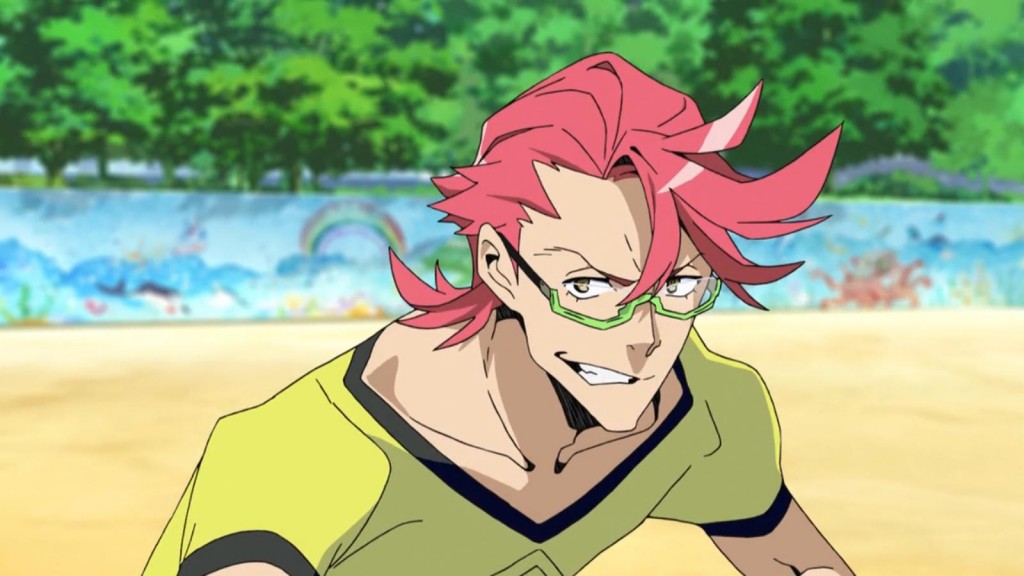
Just once, I want an anime character to have horn-rimmed glasses instead of those bottom rimmed ones.
Let’s talk about “suspension of disbelief.” To remind you, dear reader, this is the notion that, should a writer be able to insert enough humanity into their story, the reader will be able to overlook the more nonsensical elements of the narrative. This is the reason why we’re fine with stories about humans with superpowers, animals that can converse in human speech, etc. In some ways, suspension of disbelief is one of the first hurdles a story must overcome, because if a story is unable to make you “believe” what is occurring, then it leaves itself open to much greater scrutiny. And greater scrutiny means an audience less likely to forgive any of the bullshit the writer throws their way. I guess what I’m trying to get here is that Kiznaiver has failed to made me suspend my disbelief. And so it’s time to throw its bullshit right back at it.
Okay, let’s talk plot. It’s Sense8. It’s bloody, goddamn Sense8. I didn’t like Sense8. If you liked Sense8, then you can stop reading, because then this show is completely and unapologetically for those who enjoy that. I couldn’t get behind Sense8 myself, but you know what? At least the idea that all these people were connected felt like it made some sense in that universe. I didn’t watch much, it seemed to be a sort of dormant power that can awaken in some chosen individuals. I dig that. It’s a bit nonsensical, but I can believe that. Science bullshit about how these people share pain and how they are an experiment that will lead to world peace. No. First, the whole connecting these people together thing. From what I can tell, this happened in about a day’s time. You can’t do that shit in a day. First of all, you gotta create a sensory map that only deals with nociception. Considering that you want to do the entire human body, good luck with that shit and figuring out how to separate it fully from other sensations such as pleasure, much less creating a network of transmitters and transceivers. Forgoing the magic science, the core idea is stupid. “We hurt others because we don’t understand the pain of others.” No. Just no. We still hurt others even if we know how being hurt in that way feels. I would still punch someone in the face, even though I’ve been punched in the face myself. Just because I will feel the exact physical pain that someone is feeling in that moment isn’t may not make me stop an aggressive action. Maybe it could, but depending on who I am, maybe it won’t. And even forgoing THAT, we still have the aftermath of “world peace”: everyone in the world feels the same pain. Oops, little Klaus just broke his leg. Oh my, college student Hai got hit by a truck. Whoops, old man Hector just had another heart attack. Enacting this plan on a global scale just means ensuring that mankind is subjected to eternal pain and suffering to the point where someone, I don’t know, might try and do the noble thing and end that living hell for all of us. “KABOOM!” scream the nukes as they fulfill their mission of ending human civilization.
Onto characters…oi, are you seeing that bastard up there? That’s Kamina with glasses and a dye job. The main cast of characters very much feel like recolors of previous Trigger and Gainax characters, and that isn’t a good thing. I’m not going to claim to be a master at character design; I’ve been spending the past month trying to draw a Chinese-American teenager for a webcomic, and for love of God, the biggest stride I’ve made so far is giving her bloody arm bands and combat boots. But surely the minds at Trigger can put their heads together and come up with something a bit new that didn’t have me thinking that I’m watching some bizarre AU where the cast of Tenga Toppa Gurren Lagann and Kill la Kill go to high school together. And personality-wise, none of them are all that interesting. The Yoko Littner clone has caught my eye, but that’s mostly out of her weird devotion to stick by the main protagonist, who is an emotionless twat that can’t feel pain. Everyone else is just your standard suave douchebag, emotionally closed-off bitch, manic pixie girl, boastful here, etc. If they look like that one anime character you saw in that other show, then guess what? They are that one character you saw in another show. And to sidetrack back to the plot again, if emotionless twat can’t feel pain, why can the others feel it when he gets hit? Is it just a psychological thing on his part? And that girl who kidnapped all these fools said that everyone being able to feel his pain saved his life after she pushed him down a flight of stairs. How? The second episode clearly establishes that it is only the sensation that is shared, not the actual injury. And despite what the plot summary says, it really seems like the sensation isn’t diluted by being shared; it maintains its initial sting. WHAT NOW, MARI OKADA?!?!? I’M FINDING YER BLOODY PLOTHOLES!!! YOU’VE FUCKED UP, NOW!!!
…
…
…
Ahem. I suppose praise can be given to the art of the show. It’s the kind quality that you expect from a studio with a pedigree like Trigger, and from director Hiroshi Kobayashi in particular. Beautiful backgrounds and nice, kinetic animation. You know the drill. The music is nothing special, but it manages to set the mood for any given scene, so it delivers what it needs to. My only qualms come from the writing and character design. I would probably have less searing hate for the setup if the characters were remotely interesting. But they aren’t. They are all characters that I’ve seen time and time again, and nothing about their interactions or the execution of the story makes me feel anything for them. It manages to turn a show that I thought would have at least be decent but instead turns it into crap. In regards to the old running gag of “[insert thing here] has saved anime”, I’d almost put it in the camp of programming that is killing the industry. But I won’t for two reasons: it is an original property, not an adaptation, and it isn’t YET ANOTHER BLOODY MAGICAL HIGH SCHOOL LIKE HUNDRED AND—
(Editor’s Note: Rac has been taken to the white room, where he will remain for the next week. Hopefully, a steady diet of Ed, Edd n Eddy reruns and Electric Light Orchestra tracks will help him relax. We now return you to your regularly scheduled clusterfuck.) — RacattackForce
Kuma Miko: Girl Meets Bear
Upon reading the description of Kuma Miko, I was prepared to make a joke that apparently Japan has a huge We Bear Bears fanbase and has elected to write a 50 Shades of Grey style fanfic about Grizz and Chloe just to annoy us American prudes. Upon watching it… well…
My work here is done. — Lord Dalek
MACROSS Δ
So, all pretenses have been dropped, huh? I won’t pretend to have a vast knowledge of the Macross franchise, as I’ve only watched the original 1982 series “Super Dimension Fortress Macross” and the 1984 film retelling of said series, “Macross: Do You Remember Love?” But when watching both those installments a few years back, I found myself enamored by the fact that humans won less because of luck or cunning, but because we had culture and the enemy didn’t. It took the one thing that humans can lord above all other species on our planet and made that the defining factor in our win against an otherworldly menace. It was a cool approach to the whole alien invasion thing that helped make the world feel all the more real…so of course Macross Delta had to go “Screw it” and literally weaponize music itself.
Don’t misunderstand me. Macross Delta is a fine show. It has an intriguing premise going for it, what with a strange virus going around that turns people into feral monsters, setting up a nice little mystery that can be answered down the line. The characters, though admittedly just barebones archetypes at the moment, are fun to watch, have clear potential for growth, and feel like the type of protagonists you’d want for a franchise like this. And each fight is a bleedin’ dance concert, with strobe lights and bright colours all over the battlefield, turning war into a true spectacle – something also lays down some groundwork for some potentially deep commentary if they want to go that route. It’s one of the few shows of the Spring 2016 season that I can say can be enjoyed in the manner the writer and directors meant for it to be. I’m just disappointed that the undertone of music being a weapon has become an overtone of music being a weapon. While turning the latest Top 40 tracks into an actual weapon is a legitimately logical conclusion considering everything that has happened in this universe (Macross boasts a pretty simple A→B→C timeline), it still feels strange seeing that the military just straight-up put idols in mechs.
And that leads to the show’s biggest sticking point: if you can’t at the very least tolerate J-Pop, avoid this show. That advice goes for the whole franchise, but especially here. All our main characters are military as of episode two. The military is full of idols. These idols will sing. And your ears will bleed. On the flipside, if you can’t get enough of J-Pop, then…you’ll probably like it. I’m more of J-Rock guy, myself. Next Macross installment needs some Asian Kung-Fu Generation, you feel me? — RacattackForce
Mayoiga
It’s Okada time, business-snatches! She’s done card games! She’s done aliens! She’s done Lupin! What else can she do now to twist your brain and make you wish she wasn’t writing half the anime every season? By listing off the names of at least thirty characters while they’re all going on a bus trip to something that is very obviously a cult.
Maybe it’s me being stupid again, but I couldn’t tell what was going on. Is it a horror? Will it just be one of those Danganronpa-esque survival stories? Why is there a kid named Freezing Judgeness? Why did all of the kids join what is heavily implied to be either a suicide cult or a secret prison? Why do they start singing about hippopotamuses as if this is all good-hearted fun? It’s interesting to have all these questions brewing in the first episode, but the inquiries are generated less from the show’s tricks and more because you’re annoyed and wonder when somebody sane is going to start talking for once. If Okada wanted to capture the feeling of being trapped in a bus full of crazies you never want to meet again once this trip ends, she aced it there. But since this will be at least 12 weeks long, you’re expected to sympathize with these freaks. Bond with them, if you will. You just want it to end all right now if the alternative means spending eternity with these buffoons.
There will occasionally be a moment when one of the characters like the bus drivers says what’s on my mind, but then he’s drowned out by the rampaging insanity of the troupe he’s driving. I’m not sure exactly what happened in Mari Okada’s life to constantly make these bildungsromans that could only equate to a real teenager’s life if massive blows to the head were involved. It’s like how writers have flash cards to figure out what to write, but all of hers have the words “troubled teenager with ambiguous brain damage” written on them. But in a bittersweet way, I’m glad. I’m glad that she can fill that genre. If the powers that be were willing, Makoto Uezu would take her place and regale us with coming-of-age fables with the tenacity of Ranpo Kitan. Or Toshiki Inoue could creep out of his Ushio and Tora crypt to add more reasons to despise young love. So keep fighting the good fight, Okada. Even if your writing sucks, it could be worse. Much, much worse.
On the other hand, this show is the second-best comedy. So watch it for that. — Bloody Marquis
My Hero Academia
I don’t think FUNimation has EVER promoted a new simulcast as hard as they have MHA. They announced it a month in advance of it’s premiere date and ran ads on every anime website you could think of (and some you wouldn’t). They made multiple trailers, even going so far as to make character-specific promo videos, for way more characters than will probably even be relevant in the series’ first cour. To top it all off, they ran a four-hour pre-show before the premiere on Twitch from 1am-5am, which I did not stay up for because I like sleep. One has to wonder whether FUNi’s been pushing this show so hard because they knew it was one of the most anticipated shows of the season, or they did it because they wanted to make it THE most anticipated show of the season. Let’s face it, besides MHA, FUNi has jack shit else this season and they know it. Plus, with the pedigree of Bones, the brand of Shonen Jump, and the popularity of superheroes behind it, MHA had the potential to be a smash hit just like One-Punch Man was last fall. So, the question remains, is the MHA anime the masterpiece FUNi and fans have been hoping for?
Well, it has all the makings of a good show, and should prove reasonably successful. That said, the first episode isn’t likely to stir buzz off the bat like previous super hits such as Attack on Titan and One-Punch Man did. I contribute this to the decision to only adapt the first half of the first chapter. While the endpoint of the episode isn’t a bad one, it also delays the actual conclusion to Midoriya’s character arc as presented in the episode. The way this episode ends instead asks the question of whether Midoriya can be a hero without powers, whereas if the full chapter was adapted in it’s entirety, that would’ve already been answered.
The problem with simply asking the question and not answering it, in this case, is that Midoriya isn’t a particularly proactive protagonist in this episode. The only example of him being heroic is him trying and failing to stand up for a bullied kid at the beginning of the episode. That scene isn’t a particularly effective demonstration of his altruistic character, however, because the way he’s trembling and croaking up as he’s doing it makes it feel like he’s reluctantly sticking up for the kid, and is afraid of getting hurt. The fact that we don’t see him try and fight back when the bullies attack him, or later when he’s being ridiculed in school, characterizes him as spineless and weak-willed, which aren’t particular admirable traits in a protagonist. In general, there is not enough done with Midoriya in the episode to make him really likable. Sympathetic, sure; life’s given him a raw deal in the most ridiculous way. But while one can appreciate his ambition to be a hero and frustration at not having the talent and power to do so, but most of the episode’s runtime is spent establishing this and seeing him mope about it. As a consequence, he strikes the audience as a dreamer, but not a doer. While one might be naturally inclined to root for the underdog, said underdog still needs to try and earn that support by persevering despite the odds. Midoriya simply isn’t given enough to do here, and so there isn’t much to make him genuinely endearing. And while that’s immediately going to be addressed in the next episode, I feel the anime could’ve still done a better job presenting his character in a more effective way.
Starting off with a weaker character foundation really huts because MHA’s production isn’t the most impressive. It’s Bones, so obviously it looks, sounds, and moves well enough. But compared to some of their recent work like Noragami and Blood Blockade Battlefront, it’s rarely ever above average. The show does incredibly well with the two fluid and exciting fight scenes that begin and end the episode, but they aren’t on the same level as the eye-popping visual spectacles found in the premiere episodes of those aforementioned shows. Outside of the fight scenes, the show plays it safe with the general character animation, even employing limited animation for more mundane scenes. Not that there aren’t notable exceptions: the character acting on young Midoriya in his flashback weaves between subtle and exaggerated seamlessly, and the scene where he excitedly shakes back and forth in his chair waiting for All-Might’s debut video to play with such an earnest and goofy expression on his face was genuinely inspired and made me laugh out loud. But there’s sill nothing mind-blowing or technically outstanding about the show’s animation or fighting scenes thus far, which may make it easily overshadowed by more action-packed battle-shonen and other Bones shows.
The show’s music is surprisingly underwhelming. The OST is appropriately bombastic and heroic-sounding, but fails to leave much of an impression and is rather forgettable. The exception is All Might’s theme, which definitely stands out and really fits the bigger-than-life nature of the character himself. The opening and ending themes are a shamefully missed opportunity to pay tribute to classic hero show themes, instead using some tepid and generic j-pop and employing conventional anime OP & ED tropes. They’re not bad, but they don’t help give the show a distinct identity like the best shows do, nor do they do an adequate job of getting one pumped to watch it. Considering the music was one of the most praised aspects about the previews, I was surprised to find it so run-of-the-mill, but perhaps they’re saving the stronger tracks in the OST for future episodes.
I’ve heaped upon a lot of harsh criticism upon this adaption, but this really isn’t a bad premiere. In fact, it’s a pretty good one. My complaints aside, it’s colorful, fun and funny, and has enjoyable characterization and a creative world. Still, MHA is a show with a lot of hype and expectations behind it. The manga it’s based on is one of the rising stars of Weekly Shonen Jump, with the potential to fill the void Naruto left and become one of the magazine’s pillars. Even famous mangaka like Eiichiro Oda and Masashi Kishimoto themselves believe this, and have openly praised and shown their support for the series. And FUNi clearly expects this show to be a big hit considering all the effort they’ve put into making people know it exists. But while a perfectly faithful adaption, I’m worried MHA’s premiere episode just doesn’t leave quite a strong enough impression. Obviously, I know where the series is going and the heights it’ll reach in it’s storytelling and character development, but I’m judging the anime for what it is right now, and comparing it to other mainstream hits of the last few years because that’s what it’s producers and licensors want it to be. In this respect, I don’t feel the MHA anime is as good as it could be, and will reach the heights that it’s producers and manga fans want it to. But keep watching. So long as the anime doesn’t pull a FMA or Blue Exorcist and continues to follow the manga faithfully, the show will become super soon enough. — LumRanmaYasha
Less TL;DR. More Dalek Bitching
And now time for this season’s installment of overhyped Shonen Shit. Apparently Ass Class ain’t cutting it no more and Madhouse hates us too much to make more One Punch (THOSE BAAAAAAAASTARDS!!!!) so instead we have this thing from Bones. Already I’m tingling with excitement! FAIL ME! FAIL ME MOOOOOOOOOOOOOOOOOOORRR-actually so far its pretty good. I’m not going to lie, I was expecting a bland battle school series akin to Naruto and instead I got this wacky over the top bizarro shonen of intentionally bad animation (come on man, its Bones, IT HAS TO BE INTENTIONAL), awkward camera angles, grunty voice actors, and Yuuki Kaji abuse. I’ll take it!
So in a world where Syndrome got his way and now virtually everybody is super (and thus noone is), violent crimes are on the rise and so are costumed vigilantes. So many in fact that becoming a superhero is now the #1 employment choice for today’s youth and their so-called “quirks”. This is good news for our jackass rival character Katsuki and absolutely terrible news for our poor schlub loser protagonist Deku. You see 20% of the population has no super powers to speak of, and Deku (much like normal guy from the now-shit canned World Trigger) has to make like Batman. Either that or kill himself. Whichever comes first. Heck I think that giant slime monster has the solution to your little problem there Deku. Yeah, that’s the ticket… just get tentacle raped to death there… its not like some over power super hero will come and save-OH HEY ITS KEN FROM SFV I MEAN ALL MIGHT!!! See Deku, now you have something worth living for. Here, have a Tokyo Ghoul mask and 12 more episodes!
I was legitimately expecting absolute bupkiss from My Hero Academia. I knew nothing of the series other than some rather uninspiring promotional art, and the fact that it’s currently the Weekly Shonen Jump flavor of the month. This could mean its great like One-Punch or flaming dreck like World Trigger (seriously it got cancelled for sumo wrestling! BWAHAHAHAHAHAHAHAHAHA!). Amazingly though, in this case its the former, and I’m so very, very pleased. The only dread I have is if this show pulls a Ow no Blech-sorcist and legitmately turns into that crappy school show it seems to be advertising. The preview happily suggests otherwise but I’ve been fooled before. DON’T LET ME DOWN LIKE YOU DID WITH SPACE DANDY BONES. DON’T DO IT. — Lord Dalek
Threeps
Midoriya Izuku is practically the definition of a comic book nerd. He adores anything and everything having to do with superheroes, collects every piece of merchandise that he can possibly find, and flat-out models his life ideologies after his favorite heroes as his role-models. The thing is, he is a comic book fan without there actually being any comic books. Enter the world of My Hero Academia, where in the relatively near future, human evolution has progressed to a point where roughly 80% of the population are bestowed with supernatural abilities, and superheroes and villains are a dime a dozen, to the point where super powers have become a profitable commodity and the act of being a hero is a government-enforced career. The most prominent of these figures is the world’s greatest hero and Midoriya’s idol, All Might, who he one day hopes to live up to. Unfortunately for our protagonist, though, he falls into that bottom 20% of nobodies, doomed to forever admire his betters on the sidelines. However, Midoriya isn’t content with just being a fan, and plans to make it big in the world of heroes with or without any “quirks” (this world’s name for super powers) to his name. And before he can even think about entering a prestigious hero academy to initiate his training, he must first overcome the obstacle of his long-time rival/bully Bakugo, a bratty punk gifted with a powerful explosion-quirk who looks down on anyone weaker than himself, and especially someone like Midoriya who aspires to achieve greatness despite possessing nothing of worth in Bakugo’s eyes. How will Midoriya even have a chance of succeeding down his chosen path given all of the harsh obstacles stacked against him?
At face-value, here we have the premiere of a show within absolutely nothing original to offer, or so it would seem. After all, it’s yet another anime adaptation of a Weekly Shonen Jump action manga (something we seemingly have in endless supply as it is), and the concept feels like it has ripped part of itself from other popular Jump franchises such as Naruto (except replacing ninjas with superheroes, as is the modern craze around the world these days). The other part of it’s identity almost feels like it’s flat-out stealing the concept of satirizing many aspects of the modern superhero genre in Japan straight from the much-beloved Tiger & Bunny from a few years prior. You could even attribute some of this show’s make-up to taking influence from popular American comic books of a similar nature, notably two DC series in the form of Young Justice and Teen Titans.
The thing is, all of that is “technically” true. Astonishingly enough, though (at least for anyone who hasn’t already been keeping up with the insanely popular, currently-running manga serialization), the result is not by any means the Frankenstein’s-Monster-Style mess that one would probably expect from such a hodgepodge of already used ideas being crammed into one pot. Instead, Studio Bones’ anime adaptation of Kohei Horikoshi’s fan-favorite love-letter to all things superheroes showcases the promise of a great stand-alone series. It manages to stay on the better side of the line separating a brilliant homage with its own unique elements from something a lot more cash-grabby that capitalizes on what’s popular. You can see from this premiere alone that this series very wisely avoids two big mistakes that most anime in this genre tend to make: one is that it clearly is not in danger of taking itself far too seriously for its own good, and is willing to have fun with its concept, and the second is that as an adaptation, it pays a lot of careful attention to pacing and utilizing good film-making, first and foremost, over just trying to be a glorified motion-comic version of the manga.
On the first point, the director wisely chose to adapt only half of the first chapter of the manga for the premiere, rather than rushing through it to get straight to the action. Considering how densely packed with story the debut issue is, this is a wise decision, and at no point does the episode ever feel deliberately slow or mundane. On the second point, clear effort is put into the animation and voice-acting of each character, with the two main leads, Midoriya and Bakugou, clearly having distinct styles of movement and speaking to not only highlight who they are as characters, but to purposefully contrast a key conflict in their ideologies, which you can tell as a viewer from these attributes alone, even though we haven’t touched on that aspect of the series by this point. And this is just from a clever use of basic techniques such as framing and coloring, along with other subtler nuances to complement the more outspoken and over-the-top nature of the show on the surface level. The animation itself is actually a little bit below the typical standards of a contemporary show produced by Bones, but it’s how the staff uses what they have to work with that counts. While the premiere episode is by no means a masterpiece in and of itself, and probably won’t hook new viewers right away, it succeeds at setting up an interesting show through easily relate-able characters and strong world-building.
Definitely give this show a shot if you are either a fan of good shonen series, superhero comics/shows/movies, or both. — Ensatsu-ken
Fourps
My Hero Academia is the most recent series from Weekly Shonen Jump to have a decent amount of hype behind it leading into this anime adaption. Those that might not keep up with the weekly manga anthology might not understand the hype behind it, or why its fans tend to run the spectrum from 80s and 90s Golden Age fans to more recent One Piece and Naruto fans. It’s a bit of a puzzler, really. The first episode, gorgeously adapted by Studio Bones, tells the classic tale of a wannabe hero who has no chance to be a hero, and ends just as out main character, Izuku Midoriya, meets his lifelong idol to confirm if someone like him, a weakling and nobody, can really become one.
This episode, however, is mostly introduction. Newer viewers might be a bit confused as to how this series gathered its strange fanbase so quickly. For those who have read ahead in the manga, looking back and seeing Midoriya and Bakugo like this is quite eye-opening to how well Kohei Horikoshi well eventually develop his characters though to new viewers they might not realize if it is worth sticking around for yet. The episode also only covers half the first chapter, which might surprise those who have never read the manga since Horikoshi’s pace is so brisk.
However, even with this introduction, it’s very clear there is something special here that might not be so obvious at first. Those that have only checked out the anime will be well-advised to stick around and see just where the hype comes from. Fans of action and adventure are well advised to check this show out. Next week can’t come soon enough. — Spark of Spirit
Greg Fipes
It’s a strange thing, Japan doing superheroes. But it’s been done well before, and this is shaping up to be another case. While the recently hugely successful Uno-Puñetazo Hombre was more of a parody of many shonen and superhero narrative elements, MHA impressed them with a refreshing glee. We’ve got ourselves a real underdog hero. And I mean that he is a real underdog: a powerless wimp in a world where being “normal” has become abnormal. But he’s got a dream to be a hero, like no one ever was, and damn it, you really want to see him succeed. The story flows surprisingly smoothly, and Bones has done a fantastic job capturing the excitement and facial expressions of the original manga art. Sure, it gets sappy at times, but this is such a beautiful, happy, enjoyable show I can’t help wanting to see it succeed.
Sunshine Superman/10 — Shadow Gentleman
Pretty Guardian Sailor Moon Crystal Season III
Two years ago, I watched the first episode of PGSMC season 1 for the Summer Clusterfuck. Overall I thought it was an ok reboot and was looking forward (albeit with trepidation) as to where Toei was going to go with the show. It wasn’t the best start but I had some enthusiasm.
…that enthusiasm did not last…like at all.
Sailor Moon Crystal did the exact opposite of what it was supposed to do. Instead of capitalizing on long time fans’s nostalgia for the original show by giving them a far better adaptation of the manga, it managed to piss everybody who watched it off and made them even MORE nostalgic for the 90’s show. Yeah the 90s show with shit animation, endless monster of the week plots, and plot holes that are so massive you could lose a semi in them. So now its back to the drawing board for Season “3” (apparently Black Moon was the second season despite no mention of that being made at the time). Gone is the original production team off to make more seasons of Precure and Gatchaman Crowds. Instead we have a new bunch of showrunners trying to clean up the mess their predecessors made. Do they suceeed? Welllll…..
Lets start with the story itself. Its the Infinity Arc which kinda sorta served as the inspiration for fan favorite season Sailor Moon S. I say “kinda sorta” because (as with R and Super S) director Kunihiko Ikuhara frequently deviates from the story material that Naoko Takeuchi had planned (doesn’t help that the manga was several months behind the anime at this point). As such, viewers without any previous knowledge of the the manga may feel like we’ve jumped ahead 30 episodes as Chibi-usa, Diana, Setsunna Meioh, and even Hotaru Tomoe are already present. It does however start the same way with troubling visions had by Rei (shared here with Mamoru and Hotaru). In fact this version doesn’t waste any time, establishing Haruka and Michiru not as shadowy figures lurking in the background but as the world’s greatest trap and “his” girlfriend. But then suddenly black space blobs called Reversions appear, not to steal pure heart crystals but just be black blobs that must be destroyed. This is all the work of the mysterious Pharaoh 90 (yet ANOTHER character who didn’t show up in S until very late, so late in fact that he’s actually not even in the show) and his subordinate, the slinky red head Kaorinite and stems from the Mugen Academy. Time to investigate the shit out of this eh girls?
Now to the good. They actually did try to address some of the problems with the original series. Hated those crappy cgi transformation sequences? Guess what, its all 2D again! Hated those awful willowy character designs? Guess what, Usagi gained weight! Hated the fact that the Sailors in Crystal barely emoted? Guess what! They still don’t!…but they’re improving. As for the bad, well although its nice that those awful CGI transformations are no more, it still doesn’t fix the other problem with them, that they chew up what feels like five minutes of a 24-minute show. Voice acting remains consistant which means creepy annoying grandma Kotono Mitsuishi as Usagi. And although the plotline is running much much faster than in the old series, there doesn’t seem to be any real motivation to the plot (something I feel we could have had if they hadn’t wasted 5 minutes on a damn henshin). Still its a two parter and that might be addressed in two weeks (oh yeah still two week waits for episodes, dammit). Yes the knives are fully out for Crystal this time, but maybe it’ll add up to something. –Lord Dalek
Sailor Twopiter
Sailor Moon Crystal returns with a big chip on it’s shoulder. Highly anticipated when it was first announced, the poor animation, quality-control, and pacing have made it’s first two seasons universally maligned by fans and critics alike. Beyond the meme-spawning quality slipups, the series also suffered from slavishly following Takeuchi’s manga with few changes made to improve the story and cater it to a modern audience. It certainly didn’t help that the Dark Kingdom arc that begins the series is painfully boring in the original manga to begin with, and crappy CGI-animation, uninspired directing, unmemorable music, and monotone voice acting just made the experience intolerable.
Still, the show did one thing right, and that was make Sailor Moon relevant and profitable again. Merchandise sales for the series were excellent in Japan and the long-awaited home video release of the series overseas led to a resurgence in the international fandom as well. So now Toei’s hoping to keep the gravy train going by making more Crystal to remind people that Sailor Moon exists so they can sell more products and make more moolah. Everybody wins! Well, the fans don’t, but as we all know by now, Toei doesn’t really care about them, right?
Well, maybe they do. Because like with the current arc of Dragon Ball Super, it seems like Toei’s responded to fans’ complaints and have made an effort to address them. For one thing, they got the person in charge of fixing all the off model animation from the first two seasons for the home video releases to direct this season. While Chiaki Kon’s track record as a director is very hit and miss in terms of the content of her shows, she’s easily a better choice for the job than the guy who had previously only directed One Piece and Pretty Cure crap. Most of the staff has been overhauled, and this new talent is clearly more capable than their predecessors. While not outstanding, the animation is on-point in the episode and well-done during the fight scene towards the end. They ditched the awful CGI transformation sequences and have replaced them with infinitely better looking traditionally animated ones. None of the characters go horribly off-model, and they are even allowed to emote a little!
Speaking of, that’s another improvement made to this premiere. The first chapter of the arc has been halved, and while most of the episode is devoted to exposition, it also allows for more character moments and humor that were sorely missing from the first two seasons. Additionally, the characters are finally allowed to have more of a personality, especially in the cases of Makoto and Minako, whose love-struck fawning over Haruka felt very reminiscent of gags from the original anime and was the highlight of the episode for me. I’d like to think these improvements are a sign that the staff cares more about representing the property and telling the story well this time around, and are not just going through the motions like how the first two seasons did.
Sure, this might be preemptive and the show could go to crap again, but all signs seem to point to Toei finally getting their shit together and making this show with at least a shred of competency this time. Infinity is a well-beloved arc, perhaps the best arc in the entire series, so it’d be wonderful if they can do it justice and make a new animated version of it that tells the story effectively and endearingly. I remain skeptical Toei has changed for the better, but between this and the Champa arc of Dragon Ball Super, they might finally be doing right by their marquee properties and giving them the treatment they…well, they still deserve better. But at least they’re enjoyable, and I’m willing to settle for that. — LumRanmaYasha
Sailor Threenus
Aw, once again I’m “””treated”””” to another deplorable Toei serving. At this point there’s no real reason to talk about deep inhale Crystal.
Once again the awful animation and character designs coupled with the dragged out pace has made this a snore fest from the get go. And it’s only going to stay that way, just like those fucking Toonami threads on Toonzone!. There ghost towns! GHOST TOWNS PEOPLE! WAKE UP! Everybody was soon exited to have Hiatus X Hiatus on Toonami, but where’s everybody now? Oh, that’s right, probably falling asleep from how boring watching HxH on a weekly basis is! These shonentards couldn’t get a series that would actually work for Toonami, like oh I don’t know…MAGI!?! Come on! I mean, I don’t even watch Toonami and I know how STUPID this whole thing is. AND IF PASCHAL TRIES TO
Editor’s Note: The rest of the article was cut due to it’s incomprehensibility, violation of federal law, and focus on dead forums no one cares about. Thank you for understanding. Also, this was all Shadow’s doing. I had nothing to do with this. I could have stopped it though, but I didn’t.
Shut up, Marquis. — TheFilthyPhalek
5/7
RIN-NE Season 2
Whereas most Rumiko Takahashi series are love it or hate it affairs, Rin-ne is that one work of hers where everyone, even the people who like it, will admit is just okay. Because of a lack of a fervent fanbase or hatedom, it’s easily the least popular series of hers and the first season went by last year without garnering much attention from most anime viewers in the west. ANN actually stopped covering it because of lack of interest, and also because the reviewer was becoming frustrated that the romance wasn’t going anywhere. Wow, the romance stalling in a Rumiko Takahashi show? Why, I NEVER would’ve guessed…
Anyways, while the series might not be very popular over here, in Japan it did well enough in the ratings to warrant another season, which for a Takahashi-tard like myself was pleasantly surprising news. Rin-ne might not be as clever or hilarious as Urusei or Ranma, but it still has the slapstick, non-sequiturs, love of Japanese folklore, and wacky and eccentric ensemble cast that make her series so appealing to me. And on that note, this season is going to be even better than the first, because a bunch of the series’ best supporting characters are finally going to be introduced. Renge! Shoma! Left & Right! The cats! Boy oh boy, them cats. I fucking love the cats; they’re all hilarious. Case in point, the season premiere introduces Oboro, Ageha’s cat. Oboro is as vain and self-centered as his master, and the slapstick shenanigans the two get into trying to mess with each other for the pettiest of reasons is just delightful. In general, the new additions the show is going to add this season are only going to improve and diversify the level of character interactions on display and the humor elicited from playing off the characters’ various eccentricities. In this way the series manages to stay fresh pretty consistently, even if conceptually it’s never as inspired as Takahashi’s previous series. There are exceptions though, and I’m definitely looking forward to seeing those animated. Especially the Black Cat Ranking Exam. That might even rank as one of my favorite comedic storylines Takahashi’s ever written. Again, anything with the cats is fucking golden.
This is probably the most “personal” review I’ve written for the Clusterfuck since I’m solely commenting based on own tastes and not discussing any technical or objective merits or whatever. But hey, what else is there to say about that, other then the show is technically competent in it’s production and translates the material into animation well. Really, you probably already know if you’re going to watch this show or not if you saw the first season. If you haven’t, well, the series isn’t continuity heavy so you could jump in here and you’ll pick up the premise and characters pretty quickly. But considering this one of the few Takahashi shows that isn’t hundreds of episodes long (yet), you might as well start at the beginning since it won’t take you very long to catch up. Rin-ne continues to be an enjoyably understated comedy that’s definitely toned down compared to the mangaka’s previous works, but still has enough fun characters and creativity to make for an amusing watch. Obviously, I’m shamelessly biased towards Rumiko Takahashi stuff considering my username is “LumRanmaYasha” and all, but this really is an enjoyable show that I think more people ought to give a chance. Either way, I’m glad the show is back, and I look forward to seeing some of my favorite characters and storylines from the manga animated. I hope they get to Matsugo. He’s faaabulous~! — LumRanmaYasha
Shonen Ashibe GO! GO! Goma-chan
Goma-chan tells a heartwarming story about a young boy and his little white seal, who he rescues after a tragic oil spill near the arctic coast and tries to rehabilitate by putting seaweed on it’s head and raising him as a human boy. Actually, it just falls out a truck outside his house and he keeps it as a pet because it’s cute, but hey, it’s just as ridiculous a premise! But yeah, Goma-chan is a show for little kids that throws all logic out the window to get itself moving as quickly as possible. Obviously, the titular baby seal Goma is the star attraction here, since he’s who the producers of this show are clearly hoping to profit off merchandising. While Goma is undeniably cute, he also has no real character to speak of, just cooing “pew pew” and acting adowable every now and again. But Ashibe and his family are fun enough to offset this, and the way Goma is used as a prop for gags ends up being successfully amusing.
The show has many similarities to Shin Chan, not just because of it’s character designs, but also in how the main four kids basically mirror Shin and his friends. Yuma is a reluctant sceptic who thinks he’s more mature than anyone else just like Kazama, Mao is a strange quiet kid just like Bo, and Sakata is a spineless crybaby with a rotten personality just like Masao, though this show’s version is a bully rather than the one being bullied. While Ashibe isn’t as crude as Shin, he’s just as eccentric, and the show is ostensibly about him and his dysfunctional family. With all these similarities, I’d dare say Goma-chan was just a shameless Shin Chan rip-off with a gimmick tacked on to hide the fact!
…Except for the fact that this show is actually a remake of a classic 90’s anime that was based on a manga made in the late 80’s, both of which predate Shin Chan by a good many years. So, if anything…Shin Chan ripped IT off.
Well, the similarities are superficial at best. While this show might share archetypes from Shin-chan, content-wise it’s more silly and irreverent than cynical and satirical. This is a light-hearted 9-minute children’s series that isn’t likely to make any adult viewer laugh out loud, but can still put a smile on your face thanks to the childish goofiness of it’s premise and gags. While it’s probably not goma knock most people out, I personally will be more than happy to goma down every Tuesday afternoon.
Also, I don’t care what anyone says – “Goma move” is the best ED this season. I’m goma watch it again right now! — LumRanmaYasha
Shounen Maid
Hey remember that one time Foggle made us watch that really crappy hentai where the orphan kid got used as a picnic table for some rich rapist creep?
…that was better than this.
Space Patrol Luluco
Wow that love affair with Studio Trigger sure did end quickly didn’t it? If it wasn’t for Little Witch Academia 2, every guy I know would have declared Kill la Kill a fluke and completely thrown them under the bus for not living up to that success and after the abominable Inou-Battle and Ninja Slayer I don’t blame ’em. But lo! This season we have not one but TWO shows by the wayward house that Imaishi built, and unlike Kizunaiver, this one actually IS directed by Imaishi!
…its also only five minutes long and appears to have a budget only slightly better than Ninja Slayer’s. Oh god…
Well anyway, Luluco is a precocious 13 year old who lives in a Japanese city where humans and space aliens coexist publicly and peacefully. However. after her dad accidentally gets frozen solid after eating some sort of space pill, she’s forced to get a job in the Space Patrol (led by an Inferno Cop clone with Kamina shades) to cover the costs of putting him back together again. Said job involves contorting herself into a large gun to blow evil (and actually not so evil) doers away with extreme prejudice because… comedy!
Well I laughed once which I guess is something, because most of the “humor” in Luluco is just annoying. The abbreviated run time is just too manic to tell a reasonably logical story and the five cent animation just sticks out like a sore thumb. We are left ultimately with noise and confusion. A waste. — Lord Dalek
Las Segunda Opiniones
Studio Trigger broke a lot of trust when they played an unwelcome April Fools joke on fans with Ninja Slayer last year. After the atrociously uninspired Inou Battle, people had hoped that was simply a buffer series made as a necessity to fund their next pet project. Ninja Slayer’s previews looked so cool and dynamic that everyone was convinced that it would be hands down the best anime of Spring 2015. Then it came out and turned out to be a poor man’s Inferno Cop. While Inferno Cop worked thanks to it’s short episode length and tongue-in-cheek humor, Ninja Slayer was a weekly 11-minute slog that was ostensibly a parody but lacked the comedic timing and wit necessary to make it entertaining for more than a select subset of fans who enjoyed its novelty. After that fiasco, every anime critic and fan wrote off Trigger for good and never expected anything remotely inspired or unironically entertaining to ever come out of the studio again.
But now, a year after Ninja Slayer, and two years after the end of Kill la Kill, Trigger has finally produced another tv anime with the heart and creativity they were once known for. What Luluco lacks in budget it makes up for with director Hiroyuki Imaishi’s trademark wit and quirkiness. Whereas Ninja Slayer was as monotonous as mid-00’s [adult swim] cartoon, everything is constantly moving in Luluco. Gags and slapstick are dropped in quick procession with fast-cuts to punctuate the comedic timing and keep viewers’ attention always on the screen. Characters move sliding in every which way about the screen and speak in non-sequiturs. The world is colorful and filled with a delightfully diverse range of human and alien character designs that feel reminiscent of Sushio’s cartoony and expressive character designs for Kill la Kill, even though they are done by ex-Gainax animator and friend of Imaishi, Yusuke Yoshigake. If Imaishi’s shows had a consistent look and feel, this show captures the essence, and is what I think most people have wanted Trigger shows to look and sound like since Kill la Kill.
I’d be lying if I said I found this premiere laugh-out-loud hilarious, but I still found it a refreshing and pleasant surprise regardless. This show feels like it’s being made by people who are having fun making it, a sensation that has been sorely lacking in Trigger’s shows since the end of Kill la Kill. Its world is filled with creativity and the characters are endearingly energetic. While some might scoff at it’s 8-minute runtime, it’s really the perfect length for the series, allowing it to explore weird, abstract premises without them overstaying their welcome. If you’re expecting something with kickass action and social commentary like Kill la Kill or incredibly fluid and dynamic animation like Little Witch Academia, you might be disappointed, because this show is clearly more of wacky comedy with a bare-bones animation budget. But if you enjoy Imaishi’s quirky comedic sensibilities, visual style, and penchant for randomness, and are looking for an enjoyable short series to put a goofy grin on your face for a few minutes, I absolutely recommend trying this out. Luluco is the Inferno Cop/Space Dandy mash-up we never knew we wanted, and is emblematic of the kind of the show Trigger really should be making more of. — LumRanmaYasha
The Please Trigger, Focus on This Instead of Kiznaiver Opinion
If you’ve found this blog, then you surely don’t need me to explain who the hell Hiroyuki Imaishi is. And as such, you’ll know what I mean when I say that Space Patrol Luluco is “An Imaishi joint”. You’ll instantly know just what you’ll be getting yourself into should you choose to watch this short-form series. But let’s say for the sake of argument that you don’t know the director of such works as Dead Leaves, Tengen Toppa Gurren Lagann, Panty & Stocking with Garterbelt, and Kill la Kill. As a geek whose bulk of animation knowledge spans the Americas and Europe, thus leaving most things Japan to his colleagues, Hiroyuki Imaishi is one of the few Japanese television animation directors whose name I’ve committed to memory because his style is so instantly recognizable. When watching something by the co-founder of Trigger, you can expect to find frantic animation with expert staging, the mundane made weird and the weird made insane, and perhaps some juvenile axioms masking some interesting commentary. Or just plain juvenile humour. Depends on what he’s feeling that day. In any case, “Imaishi = Silly, Fun Nonsense” is basically all you need to know, and is basically all that Space Patrol Luluco is. The comedy comes fast, the world is bizarre, the small budget is made-up for in style, and the opening titles have some damn catchy music. The basic idea of “average girl becomes part of a space patrol” is all the setup needed to fuel moments as quiet as Luluco thinking about her feelings for AΩ Nova or as spontaneous as her turning into a giant gun during an exam. And as a gag series that you watch eight minutes a pop, there isn’t any need for major expansion on this premise or an in-depth exploration of the world, though the audience is given a few explanations about how Luluco’s hometown ultimately became residence for both humans and extraterrestrials. Space Patrol Luluco is purely a fun cartoon that walks in to make you chuckle for a bit, then lets you go on your merry way while instilling a bizarre urge to play Mighty Switch Force…because seriously, am I the only one getting some WayForward vibes from this anime!? I can’t be right!? I just can’t!! — RacattackForce
Super Lovers
Tragedy struck Crunchyroll when a nation-wide boycott happened to protest the streaming of “Super Lovers”, a boizu rabu-type show. “I didn’t want my animes to be tainted by such homosexual filth!” one protester said. “I’m okay if it’s lesbians who get caught up in underage incestuous antics, but when it’s men I just turn on my inner Fred Phelps and protest their existence!” Others offered more constructive criticism, as another protester said, “I don’t approve of a show teaching grown men to groom their little brothers. Anime fans are too impressionable and could possibly use this as ammo to groom and eventually molest their own younger male family members. And this is coming from a life-long fan of Papa to Kiss in the Dark.” Despite most anime fans’ inability to rape and molest children due to evolutionary ridges in their skull structure, many protestors are worried this show will act as a mental trigger within their bodies, causing them to go mad and put their sexual organ within anything nearby that even resembles a small child, like a used raccoon.
Looking for the other side to this story, we rammed through Crunchyroll offices to get an answer. However, CEO Kun Gao refused to comment on this situation, instead wanting to focus his endeavors on goading Youtubers to whore out his streaming service. Series director Shinji Ishihira offered his piece on the debacle, but none of us know how to read moon runes so whatever.
Esteemed critic Marron Fartin’ obliged to offer his opinion without warning, suggesting that this show “will open new gateways for the average anime fan, showing them that it’s okay to jack off to guys while denying that you’re anything but straight. Besides, the manga starts to suck once Ren grows up.” Other esteemed critic going by the alias Jacques Assless Chaps argued that we should not heed concern to this controversy, as this will all blow over since “Studio Deen does not know how to draw hot guys.” Yet another esteemed critic who wished to remain anonymous lamented that shows like these are produced while “none of Shimaji’s work will ever see an anime adaptation.” The debate regarding this show’s artistic merit rages on, while freelance doorknob-licker Bloody Marquis retorted the previous critics’ claims with “The fuck was with the Pomeranian? There was a Pomeranian in Dance with Devils too. What’s the deal with that? Are Pomeranians just the new symbol of romance? Like, what the fuck?”
Terra Formars 3: Return of the Revenge: With a Vengeance
Terraformers is not an anime I enjoy for it’s plot, characters, animation, soundtrack, narrative structure, or strangely offensive looking antagonists. Well, I do, but not in a legitimate sense. Most of the show is just people being killed by insects in increasingly horrific ways while they cry about their dead girlfriends. The characters are still flat, and everything just kind of happens with very little explanation. What Attack on Roach Pillar Men does fulfill is my need for horribly censored gore and stupidly over the top attempts at drama, and it doesn’t disappoint. The plot isn’t worth discussing, because it’s the same plot Terraformers always has: people go to Mars to fight bug guys, bug guys corner and kill most of them, survivors plot to fight them again. Rinse, rewind, and repeat for another cour and we got ourselves a weekly dose of guilty pleaser. So if you want a good stupid anime in the vain of classic 80s OVAs, then this is the anime for you!
Chiseled insect abs/10 — Shadow Gentleman
Tonkatsu DJ Agetaro
So apparently cooking and DJ-ing are the same thing because they both involve working to some sort of rhythm. But if that’s the case isn’t everyone is qualified to be a DJ since most jobs involve making repetitive noise or moving to a rhythm in some way? I do not approve of this cultural appropriation of the sacred art of DJ-ing by these groove-less fast-food conglomerates. Well, I might have been able to overlook it if the show legit dropped some sick beats, but it’s music is lame as fuck. Also, what’s up with dubbing over the DJ’s English slang with grammatically correct Japanese? Bad enough that they have the DJ speaking in such broken English in the first place. Oh Japan, you and your horribly insensitive stereotypes of black people. Anyways, if you want a really rocking show about a DJ, I’d suggest you watch Major Lazer over this snore-fest. Seriously, that shit is tight! — LumRanmaYasha
Twin Star Exorcists
I need to add a new entry to my anime drinking game: “Take a shot every time the first episode starts in a burning building or generally enflamed area”. Example… just two days ago I watched HUNDRED, a shallow piece of regurgitated LN trash that started in a burning city. Now I watch Twin Star Exorcists, a shallow piece of Jump Square trash that starts on a battlefield engulfed in flames. It’s like the latest permutation of Madoka’s “Bad End as Bad Dream” thing. What does have anything to do with anything? Beats me but it sure looks sexily apocalyptic!
So in a world that is, and I quote… “stained with sins and KEGARE but worth fighting for” (whatever the hell KEGARE is), we are introduced to tsundere bitch Benio and average unlucky shlub Rokuro. Benio is some sort of super exorcist who opens dimensional holes to a world of blood of guts, and Rokuro just sucks and has bad teeth. Well actually he only just started sucking recently, two years ago Rokuro was a better exorcist than Benio but then one of those Tragedy of Vashtarl type things happened with all the blood and guts and the screaming and the yelling and the Bill Cosby-ing. Actually little of this important. The characters just seem to wander from location to location while shitty dubstep plays. This is not helped by the awful pacing that makes me feel like I’ve just skiped through 2-3 manga chapters and still can’t be paid to care.
In the end, Twin Star Exorcists is just another one of those post-Titan feaux-edgy shounen adaptations. The kind where tons of red paint makes you want to feel like a bad ass but lines like “If you die..you don’t get to eat ohagi anymore.” just make you an ass. Nothing short of a waste. Skip. — Lord Dalek
Apathetic Opinion
I tried watching this episode from beginning to end, but blanked out. I just can’t care about that. Even most of the notes I wrote for this episode were just “Meh” jotted down a dozen times. So instead of caring enough to focus on that, I watched Ip Man 3. That’s a cool movie about Bruce Lee’s teacher having to maintain the dignity of his Wing Chun martial arts all while fighting Mike Tyson. I admit I was mostly watching the film just to see the fight between him and Donnie Yen, but Ip Man 3 transcends that expectation through invigorating direction seldom seen in martial arts movies. While not as good as the previous two Ip Mans, Ip Man 3 offers a simultaneously melancholy yet hopeful take on China’s relationship with traditional combat. Instead of watching this anime, I strongly suggest you all watch the Ip Man trilogy. They’re all pretty cool movies with inventive fight scenes and stunning cinematography, even if they all have the plot of Rocky IV. — Bloody Marquis
Sympathetic Opinion
Pierrot’s track record with their popular shonen and seinin action properties hasn’t been impressive these last few years. Besides stubbornly dragging out Naruto Shippuden for over a year and a half since the manga’s conclusion, they also fucked up Tokyo Ghoul, one of the most popular manga currently-running, by rushing though the manga’s story, diverging, and creating their own weird abstract storyline with increasingly uglier aesthetics. The trailers for TSE didn’t look any more promising, to say the least. The character designs were off model, the colors were gaudy, and the animation was unrefined. By all means, TSE looked like it was going to be another poorly made adaption of a shonen action manga, marred by the Pierrot’s trademark poor pacing and production values.
But surprisingly…there seems to be actual effort put into the show’s presentation! The animation is of sound quality and is impressive during action sequences, and the show does a good job distinguishing the human and Kegare worlds by using distinct color schemes. The pacing is on-point, spending half the episode introducing us to the titular Twin Stars individually before pairing them together for the second half. Unnecessary scenes have been cut from the manga to improve the flow of the story, with changes like downplaying unimportant tertiary characters and introducing supporting character Mayura earlier creating a more streamlined continuity that will benefit the show down the line. It seems like genuine thought and care was put into presenting the world, characters, and story in a compelling and effective manner. While one might find the show’s premise and archetypes tired and typical of the supernatural battle shonen subgenre, the stylistic choices director Taguchi Tomohisa makes, such as introducing characters with monochrome freeze-frames and the use of slow-motion and cross cuts during Benio’s fighting scenes makes the overall presentation more memorable and distinct than it’s by-the-numbers plotline might’ve otherwise.
I reviewed the first chapter of the Twin Star Exorcists manga back when Shonen Jump previewed it last year, and what I said about TSE’s story back then still applies to this premiere. While not a terribly original premise, the contrasting personalities and philosophies of the two leads provides the series an intriguing relationship, and a means to explore these characters in a compelling manner. I’ve since caught up with the manga, and while the series never really breaks from it’s shonen tropes and trappings, it’s at it’s best when focusing on the relationship and correlative character development of it’s lead characters. The decision to add more scenes to establish and explore Benio’s character before she meets Rokuro indicates that the director understands that the series is at it’s best when it’s focused on the two in equal spades and together, rather than primarily through Rokuro’s perspective as is often the case in the manga. It’s an appreciable change that enhances the quality of the material by establishing both characters and their perspectives as equally important. The stronger foundation provided for the relationship here amongst other changes to the source material shows the staff has an acute understanding of it’s strengths, and will take advantage of them to make an effective and superior adaption.
While not the most impressive entry in the genre, TSE’s inspired production and unique central relationship help make it more than just another uninspired psuedo-edgy shonen ghost-buster. It’s nice to see Pierrot put effort into one of their action shows again, and while perhaps not the best new shonen action show to come out of the season, it’s still a solid and enjoyable entry worth checking out. — LumRanmaYasha
Ushio & Tora: 2nd Season
Our favorite hyperactive kid and his snarky tiger pal not named Calvin and/or Hobbes are finally back! And while the new opening might not be as metal as the first, the show hasn’t lost any momentum whatsoever, diving headfirst into a whole new arc and dunking our heroes into troubled waters. Not only has everyone lost their memories of our titular pair, but the entire Koumei Sect has been turned to stone, their demon friends have become their enemies, and Mayuko’s been kidnapped in order to be sacrificed to create a new Beast Spear. So much plot happens in this 24-minute episode that it’s remarkable the audience ever gets a chance to breathe, but lo and behold, the series slows down just enough for a few key scenes of heartwarming character moments. The friendships between Ushio & Tora, Ushio & Asako, and Asako & Mayuko are all tangibly affecting and endearing, and founding the stakes on the characters’ relationships with their friends brings a thematic cohesiveness to the plot and leads to some satisfying character development. The show steps so naturally back into the pace of things here that it feels like it never even left.
I’m rarely this short with my Clusterfuck reviews, but really, what else is there to say? Ushio & Tora continues to be a fresh and fun shonen adventure, and this final cour looks to be some of it’s best material yet. The production quality has even improved since where the show last left off, with several scenes in the episode boasting some charming character animation that add so much vitality to these characters and the world they inhabit. Nishimura’s expertise as a director shine through in his pacing and shot compositions, and the opening sequence showing Hakumen no Mono’s backstory in particular is a good microcosm for his skillful ability to tell an effective and compelling story in a short amount of time. While not an ideal place for newcomers to jump in, there’s no doubt fans of the first season will have a lot to look forward to in the weeks ahead. — LumRanmaYasha
Second Gear
One of the surprise hits of the 2015 Summer/Fall season really came out of nowhere. The first season of Ushio & Tora was classic 90s shonen at its best filtered through MAPPA and Satoshi Nishimura’s careful adaption of the material at a very brisk pacing. The original manga by Kazuhiro Fujita ran 33 volumes and this anime will end this season with a total of 39 episodes and the staff is making use of every moment. The odd part, is that you can’t really tell.
The advantage to a series like Ushio & Tora being so old (it started in 1990 and ended in 1996) is that it predated almost every modern cliché in the genre. You’re not going to see the main character go through training arcs, have 20 point IQ, or fight villain after villain as the story stands still. For 26 episodes the show has charged forward, every seemingly throwaway character and episode coming back around again which makes it a joy to watch.
On the other hand, this means the second season is really for fans that have kept up. It’s not a starting point for new watchers. This season will contain only 13 episodes to the first season’s 26 and will close up the story. The first episode features some gorgeous direction and high octane direction, typical of the Ushio & Tora style, but if you don’t know these characters yet I’d say you’re missing out.
If you prefer the genre back when it was a more pure experience of action and adventure, you really can’t go wrong with Ushio & Tora. But you should start with the first season. — Spark of Spirit
5-14-4-21-20-! 8-15-3-8 8-5-3-8-!
